Flowerplay
The inspiration for this set of 12 drawings came from my childhood Spears toy set of Flower Play plastic flowers. The box had printed assembly instructions on the lid to put the various flower parts together to make 12 specific flowers as well as a suggestion to re-make them and create your own designs. I remember playing with this set with great concentration and, upon re-discovering this box so many decades later, I was inspired to investigate its contents again- but this time as an artist. I decided to combine the specific flower alongside it's assembly instructions and toys from my collection. I wanted to give each flower a story and I used coloured pencil crayon on paper to evoke drawing materials from my childhood. I have tried to suggest the atmosphere of a fairy tale and create images both beautiful and unsettling: to use rigorous representational drawing to present something both specific and mysterious. Each drawing was made specifically to fit a vintage frame.
-
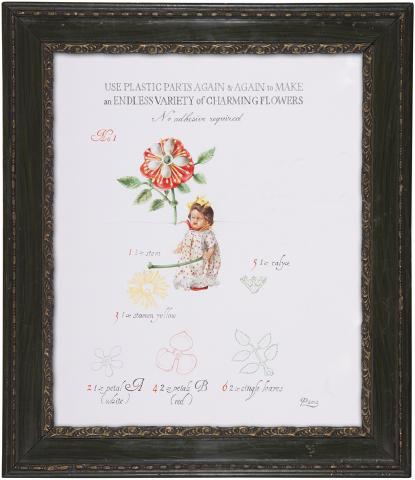 Flowerplay (Use plastic parts)
Flowerplay (Use plastic parts)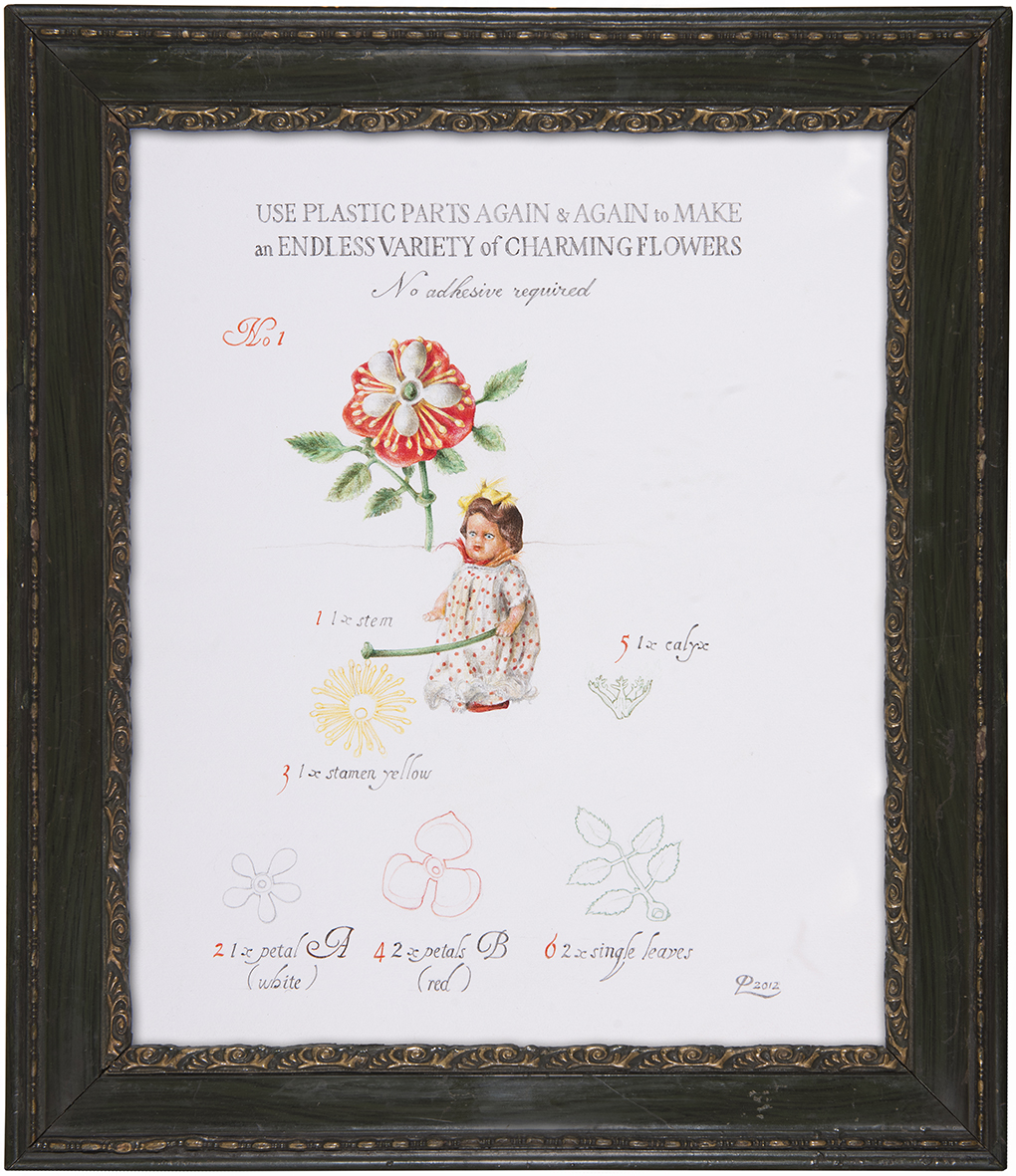 Flowerplay (Use plastic parts)This was the first drawing in this series and as a way into the project I decided to show the flower and its constituent parts in the manner of a botanical illustration. The little doll is from my childhood doll house and she is touching the reproductive parts of the flower together. I was mindful of the lost innocence of childhood, the 'respectabie' tradition of girls and women being taught to draw flowers, and the tremendous artistic and scientific botanical achievements of women such as Marianne North (1830-1890) to today.
Flowerplay (Use plastic parts)This was the first drawing in this series and as a way into the project I decided to show the flower and its constituent parts in the manner of a botanical illustration. The little doll is from my childhood doll house and she is touching the reproductive parts of the flower together. I was mindful of the lost innocence of childhood, the 'respectabie' tradition of girls and women being taught to draw flowers, and the tremendous artistic and scientific botanical achievements of women such as Marianne North (1830-1890) to today.
h:37cms x w:32cms (framed).
Coloured pencil on cartridge paper
2012 -
 Flowerplay (Use plastic parts)
Flowerplay (Use plastic parts)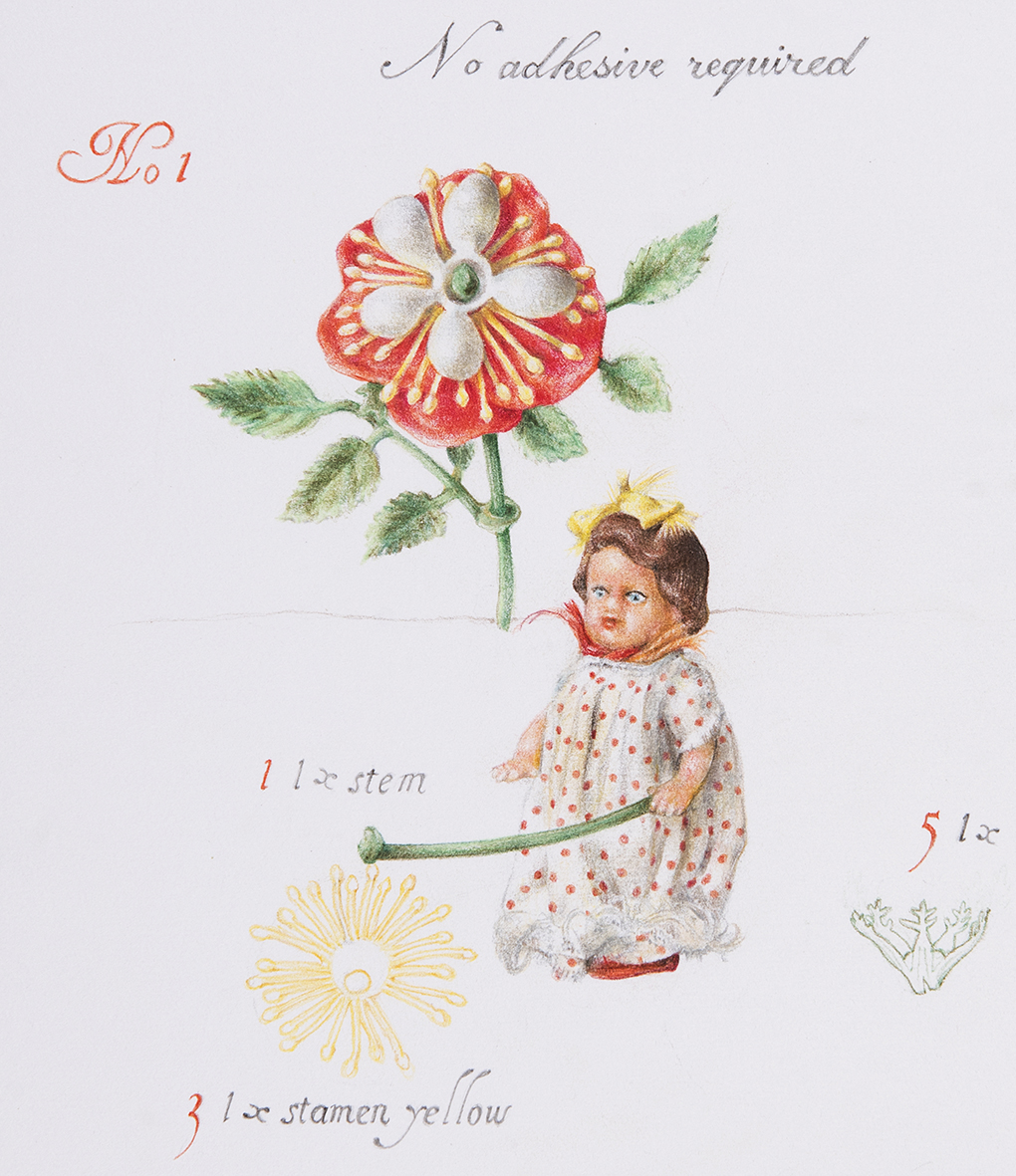 Flowerplay (Use plastic parts)This was the first drawing in this series and as a way into the project I decided to show the flower and its constituent parts in the manner of a botanical illustration. The little doll is from my childhood doll house and she is touching the reproductive parts of the flower together. I was mindful of the lost innocence of childhood, the 'respectabie' tradition of girls and women being taught to draw flowers, and the tremendous artistic and scientific botanical achievements of women such as Marianne North (1830-1890) to today.
Flowerplay (Use plastic parts)This was the first drawing in this series and as a way into the project I decided to show the flower and its constituent parts in the manner of a botanical illustration. The little doll is from my childhood doll house and she is touching the reproductive parts of the flower together. I was mindful of the lost innocence of childhood, the 'respectabie' tradition of girls and women being taught to draw flowers, and the tremendous artistic and scientific botanical achievements of women such as Marianne North (1830-1890) to today.
h:37cms x w:32cms (framed).
Coloured pencil on cartridge paper
2012 -
 Flowerplay (Use plastic parts)
Flowerplay (Use plastic parts)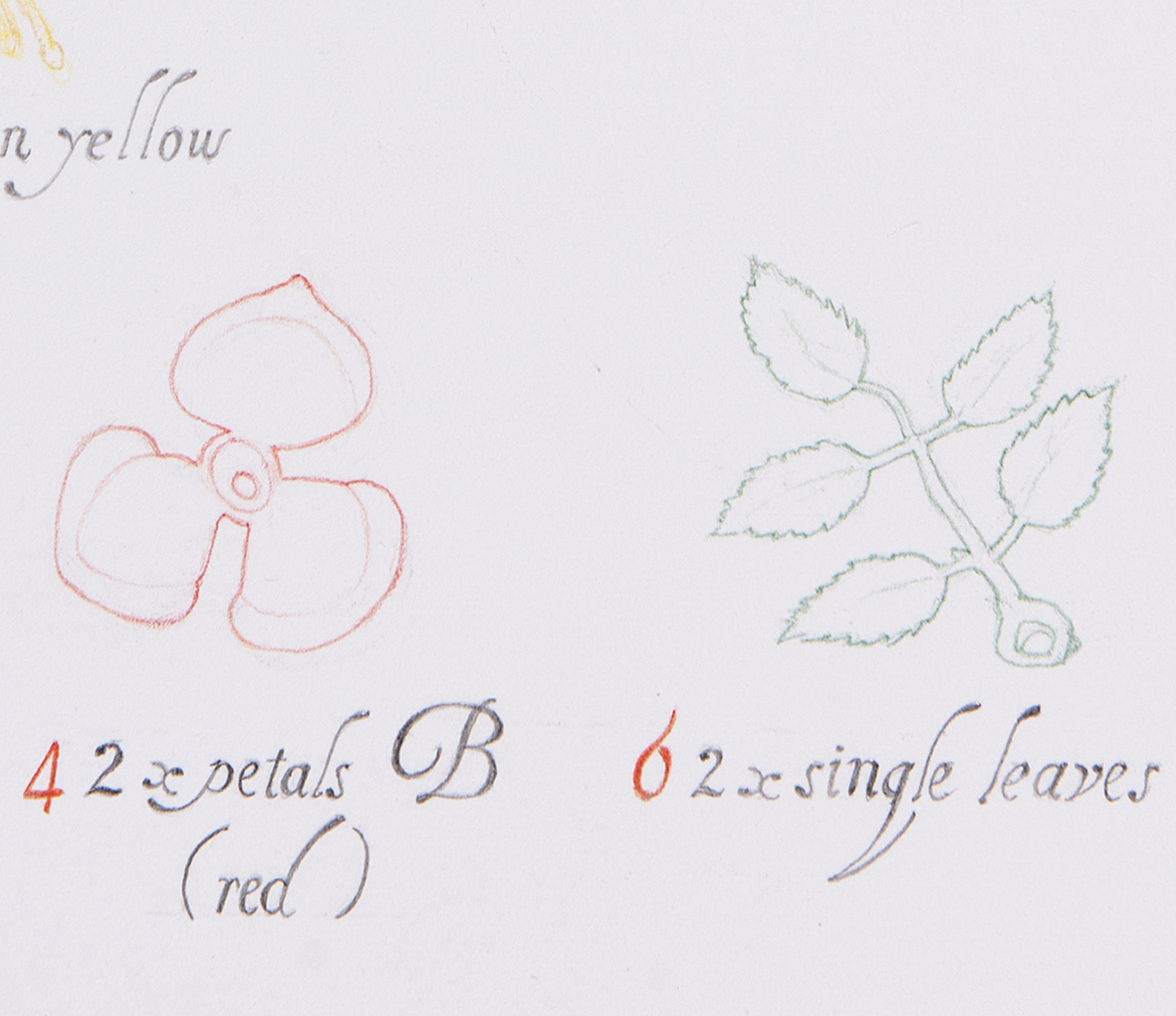 Flowerplay (Use plastic parts)This was the first drawing in this series and as a way into the project I decided to show the flower and its constituent parts in the manner of a botanical illustration. The little doll is from my childhood doll house and she is touching the reproductive parts of the flower together. I was mindful of the lost innocence of childhood, the 'respectabie' tradition of girls and women being taught to draw flowers, and the tremendous artistic and scientific botanical achievements of women such as Marianne North (1830-1890) to today.
Flowerplay (Use plastic parts)This was the first drawing in this series and as a way into the project I decided to show the flower and its constituent parts in the manner of a botanical illustration. The little doll is from my childhood doll house and she is touching the reproductive parts of the flower together. I was mindful of the lost innocence of childhood, the 'respectabie' tradition of girls and women being taught to draw flowers, and the tremendous artistic and scientific botanical achievements of women such as Marianne North (1830-1890) to today.
h:37cms x w:32cms (framed).
Coloured pencil on cartridge paper
2012 -
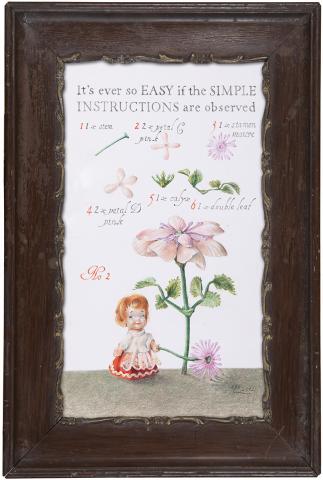 Flowerplay (It's ever so easy)
Flowerplay (It's ever so easy)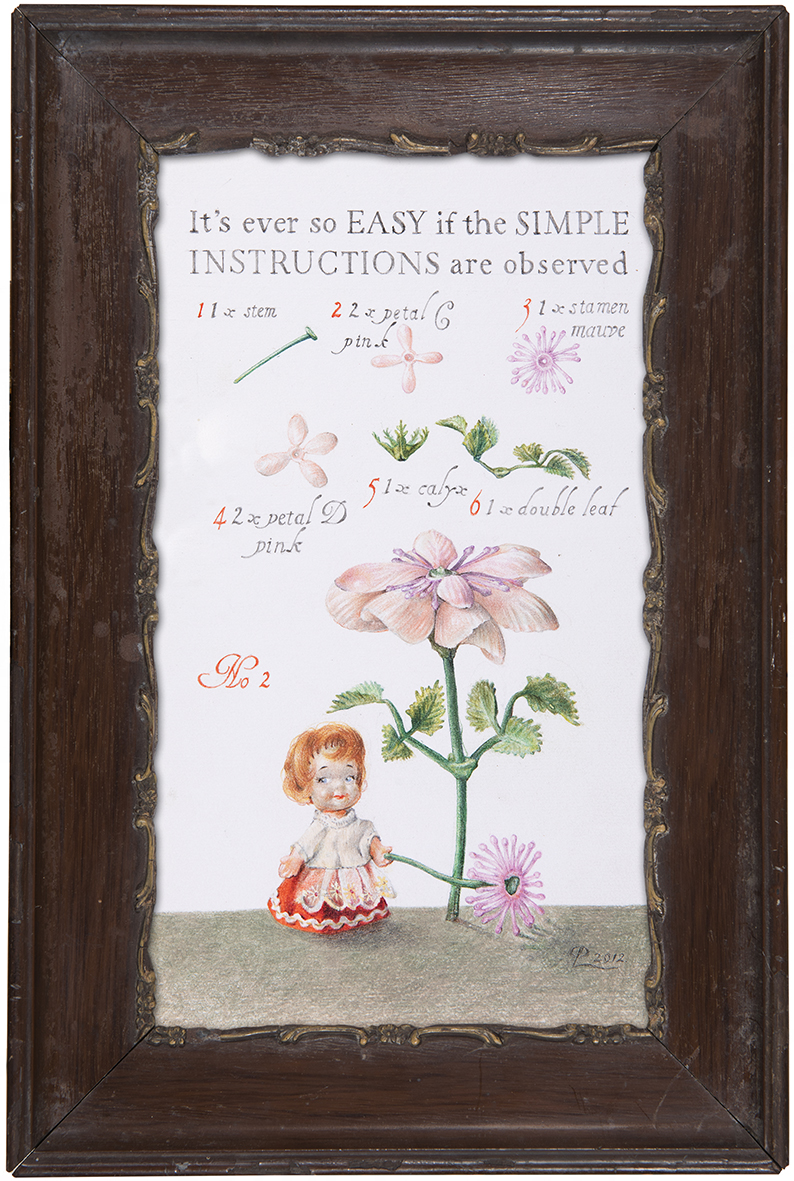 Flowerplay (It's ever so easy)This second drawing in this series developed from the first with more colour in the flower parts and some ground for the doll to stand on. As in the previous drawing, I decided to show the flower and its constituent parts in the manner of a botanical illustration. The little doll is from my childhood doll house and she is touching the reproductive parts of the flower together. I was mindful of the lost innocence of childhood, the 'respectabie' tradition of girls and women being taught to draw flowers, and the tremendous artistic and scientific botanical achievements of women such as Marianne North (1830-1890) to today.
Flowerplay (It's ever so easy)This second drawing in this series developed from the first with more colour in the flower parts and some ground for the doll to stand on. As in the previous drawing, I decided to show the flower and its constituent parts in the manner of a botanical illustration. The little doll is from my childhood doll house and she is touching the reproductive parts of the flower together. I was mindful of the lost innocence of childhood, the 'respectabie' tradition of girls and women being taught to draw flowers, and the tremendous artistic and scientific botanical achievements of women such as Marianne North (1830-1890) to today.
h:31.8cms x w:21.6cms (framed).
Coloured pencil on cartridge paper
2012 -
 Flowerplay (It's ever so easy)
Flowerplay (It's ever so easy)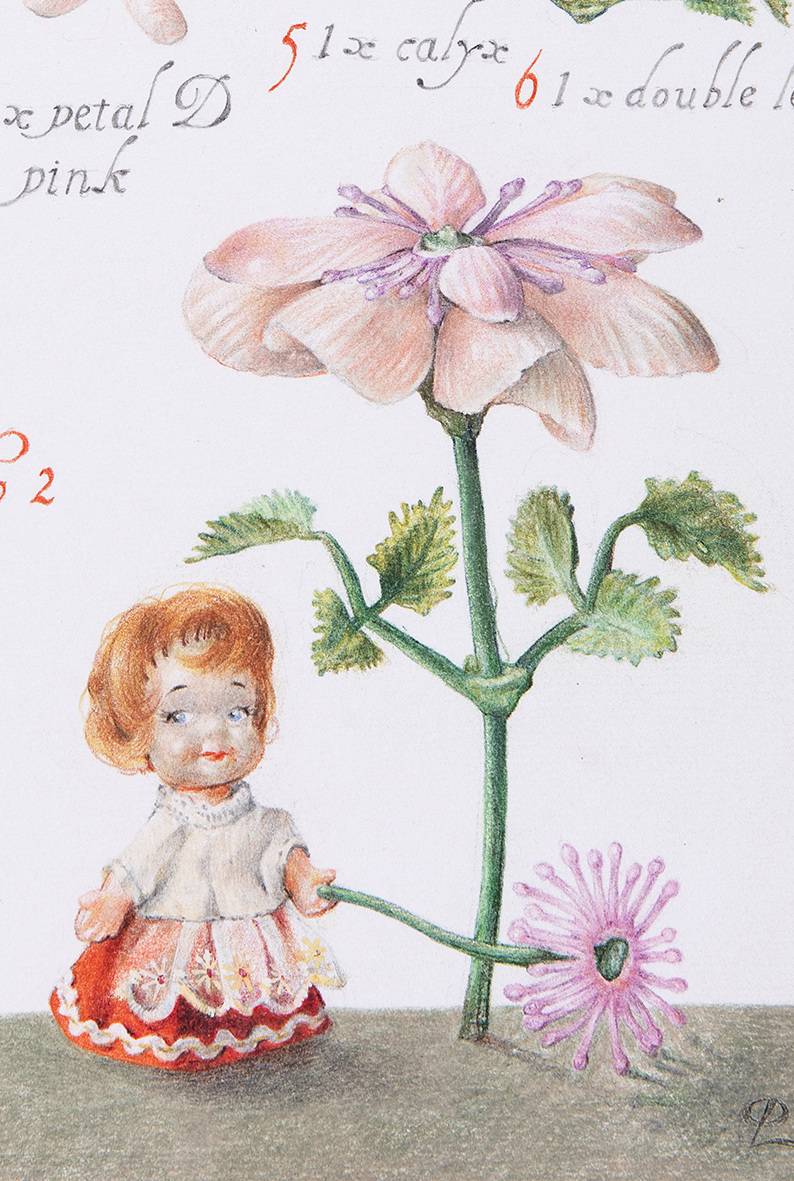 Flowerplay (It's ever so easy)This second drawing in this series developed from the first with more colour in the flower parts and some ground for the doll to stand on. As in the previous drawing, I decided to show the flower and its constituent parts in the manner of a botanical illustration. The little doll is from my childhood doll house and she is touching the reproductive parts of the flower together. I was mindful of the lost innocence of childhood, the 'respectabie' tradition of girls and women being taught to draw flowers, and the tremendous artistic and scientific botanical achievements of women such as Marianne North (1830-1890) to today.
Flowerplay (It's ever so easy)This second drawing in this series developed from the first with more colour in the flower parts and some ground for the doll to stand on. As in the previous drawing, I decided to show the flower and its constituent parts in the manner of a botanical illustration. The little doll is from my childhood doll house and she is touching the reproductive parts of the flower together. I was mindful of the lost innocence of childhood, the 'respectabie' tradition of girls and women being taught to draw flowers, and the tremendous artistic and scientific botanical achievements of women such as Marianne North (1830-1890) to today.
h:31.8cms x w:21.6cms (framed).
Coloured pencil on cartridge paper
2012 -
 Flowerplay (It's ever so easy)
Flowerplay (It's ever so easy)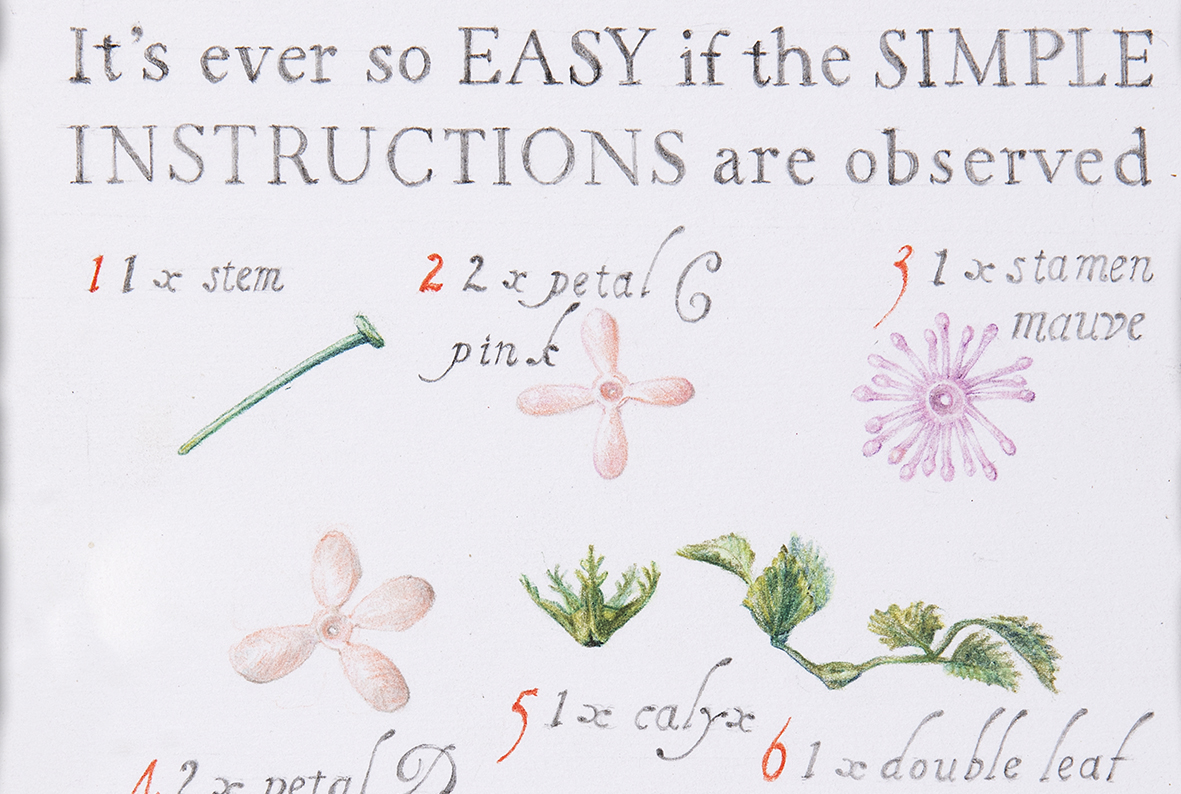 Flowerplay (It's ever so easy)This second drawing in this series developed from the first with more colour in the flower parts and some ground for the doll to stand on. As in the previous drawing, I decided to show the flower and its constituent parts in the manner of a botanical illustration. The little doll is from my childhood doll house and she is touching the reproductive parts of the flower together. I was mindful of the lost innocence of childhood, the 'respectabie' tradition of girls and women being taught to draw flowers, and the tremendous artistic and scientific botanical achievements of women such as Marianne North (1830-1890) to today.
Flowerplay (It's ever so easy)This second drawing in this series developed from the first with more colour in the flower parts and some ground for the doll to stand on. As in the previous drawing, I decided to show the flower and its constituent parts in the manner of a botanical illustration. The little doll is from my childhood doll house and she is touching the reproductive parts of the flower together. I was mindful of the lost innocence of childhood, the 'respectabie' tradition of girls and women being taught to draw flowers, and the tremendous artistic and scientific botanical achievements of women such as Marianne North (1830-1890) to today.
h:31.8cms x w:21.6cms (framed).
Coloured pencil on cartridge paper
2012 -
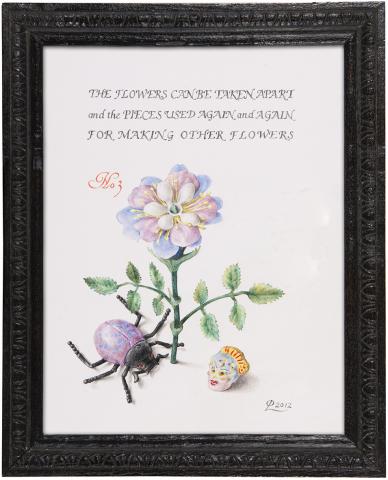 Flowerplay (The flowers can be taken apart)
Flowerplay (The flowers can be taken apart)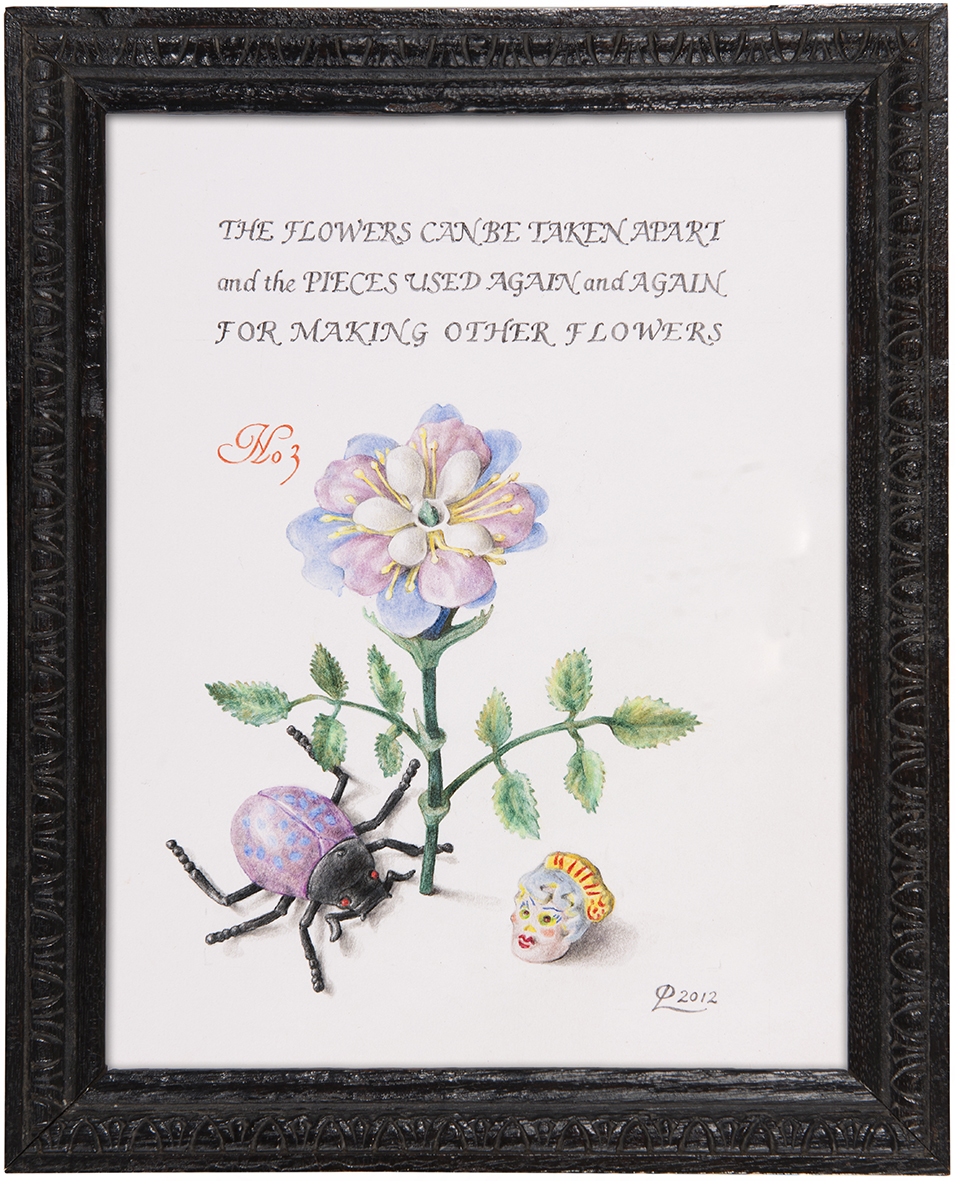 Flowerplay (The flowers can be taken apart)This is flower number 3 from the instructions on the box and I combined it with one of my favourite toy beetles that my son used to play with, alongside a Day of the Dead brooch made by a friend. Using these toys I am referencing 17th century Dutch still life painting.
Flowerplay (The flowers can be taken apart)This is flower number 3 from the instructions on the box and I combined it with one of my favourite toy beetles that my son used to play with, alongside a Day of the Dead brooch made by a friend. Using these toys I am referencing 17th century Dutch still life painting.
h:26.7cms x 21.7cms (framed).
Coloured pencil on cartridge paper
2012 -
 Flowerplay (The flowers can be taken apart)
Flowerplay (The flowers can be taken apart)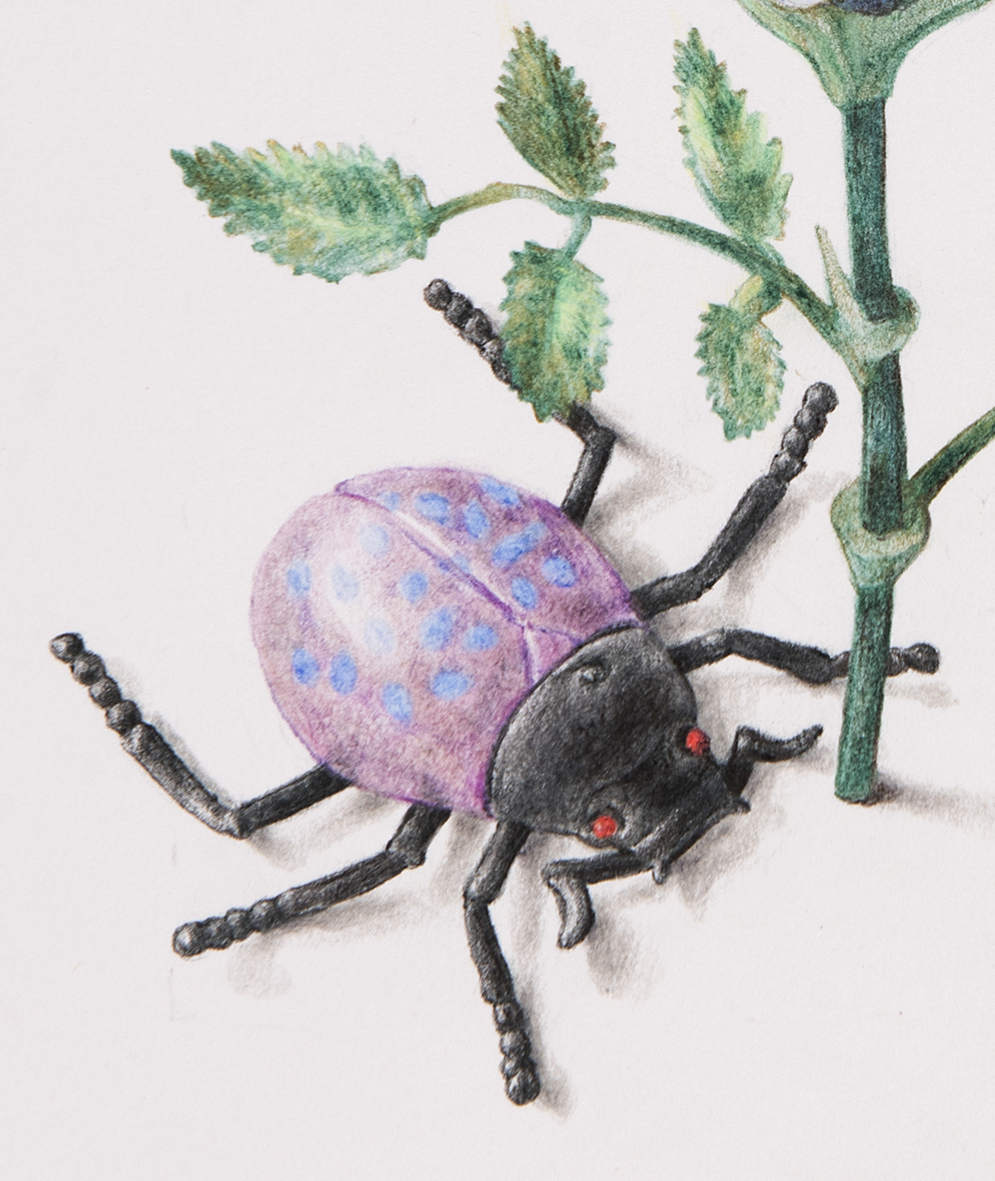 Flowerplay (The flowers can be taken apart)This is flower number 3 from the instructions on the box and I combined it with one of my favourite toy beetles that my son used to play with, alongside a Day of the Dead brooch made by a friend. Using these toys I am referencing 17th century Dutch still life painting.
Flowerplay (The flowers can be taken apart)This is flower number 3 from the instructions on the box and I combined it with one of my favourite toy beetles that my son used to play with, alongside a Day of the Dead brooch made by a friend. Using these toys I am referencing 17th century Dutch still life painting.
h:26.7cms x 21.7cms (framed).
Coloured pencil on cartridge paper
2012 -
 Flowerplay (The flowers can be taken apart)
Flowerplay (The flowers can be taken apart)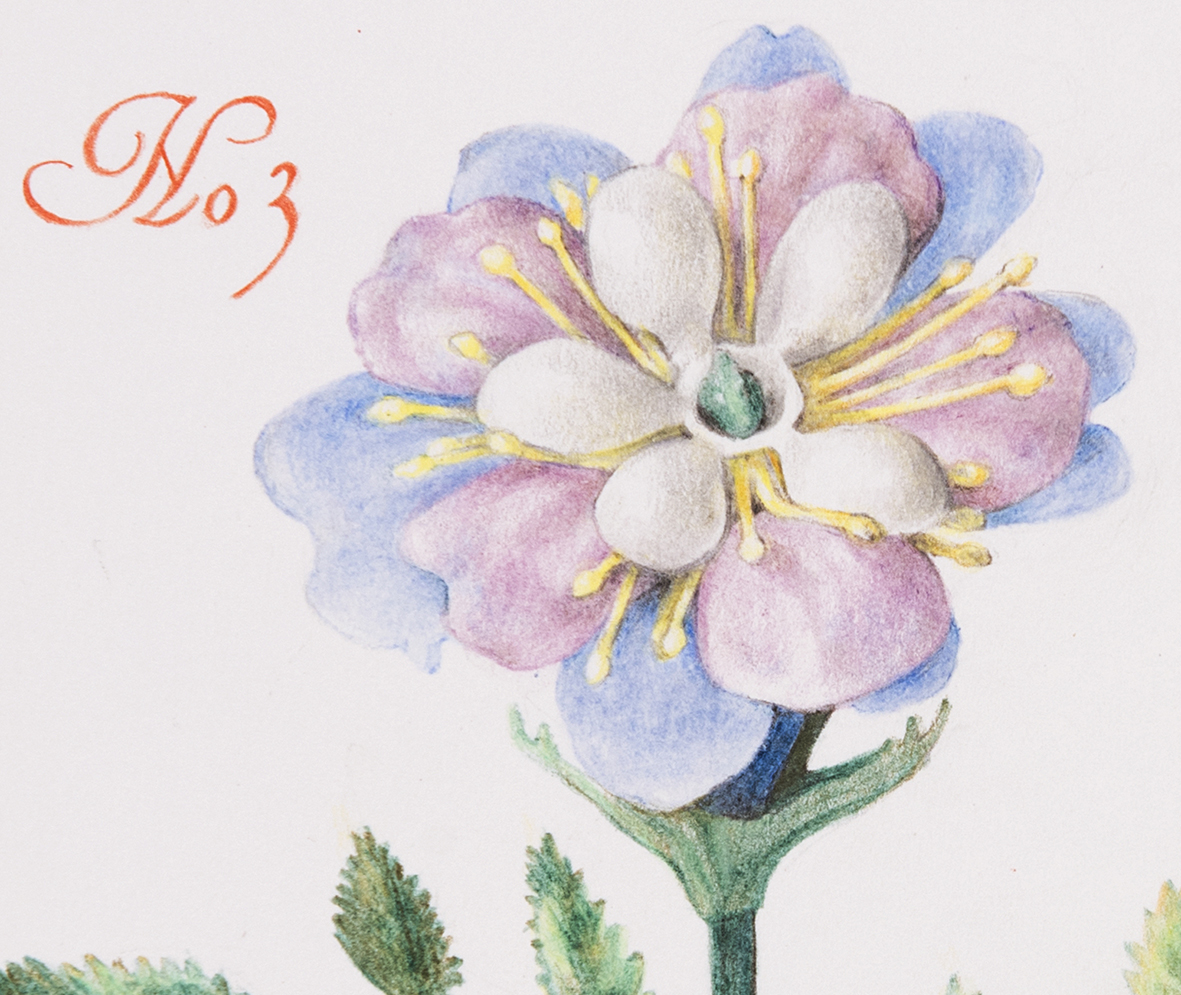 Flowerplay (The flowers can be taken apart)This is flower number 3 from the instructions on the box and I combined it with one of my favourite toy beetles that my son used to play with, alongside a Day of the Dead brooch made by a friend. Using these toys I am referencing 17th century Dutch still life painting.
Flowerplay (The flowers can be taken apart)This is flower number 3 from the instructions on the box and I combined it with one of my favourite toy beetles that my son used to play with, alongside a Day of the Dead brooch made by a friend. Using these toys I am referencing 17th century Dutch still life painting.
h:26.7cms x 21.7cms (framed).
Coloured pencil on cartridge paper
2012 -
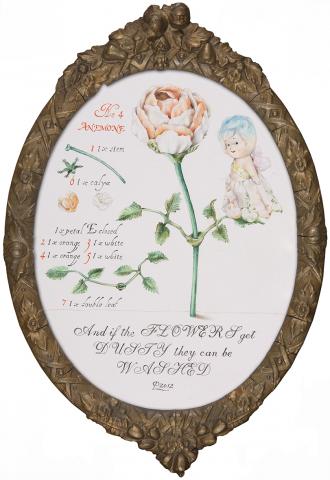 Flowerplay (Anemone)
Flowerplay (Anemone)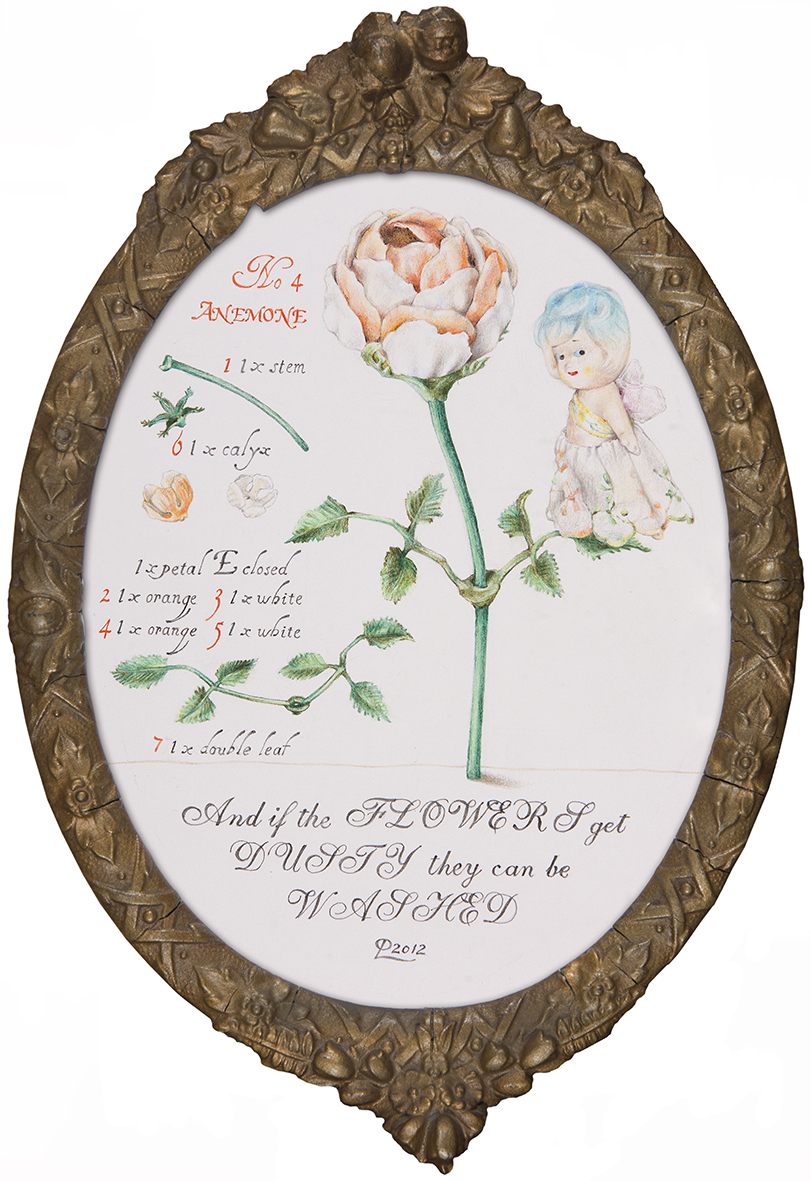 Flowerplay (Anemone)This is one of the few toy flowers based on real plants. I came across the folklore tale of fairies sleeping in the petals of anemone flowers at night, so I placed a fairy from my dolls' house alongside the Flower Play anemone for her to sleep in. She was a particular favourite of mine because I could re-shape her wings, she had a lovely embroidered skirt and her blue hair was iridescent (which I managed to capture with ink).
Flowerplay (Anemone)This is one of the few toy flowers based on real plants. I came across the folklore tale of fairies sleeping in the petals of anemone flowers at night, so I placed a fairy from my dolls' house alongside the Flower Play anemone for her to sleep in. She was a particular favourite of mine because I could re-shape her wings, she had a lovely embroidered skirt and her blue hair was iridescent (which I managed to capture with ink).
h:32.4cms x w:22.3cms (framed).
Cartridge paper
2012 -
 Flowerplay (Anemone)
Flowerplay (Anemone)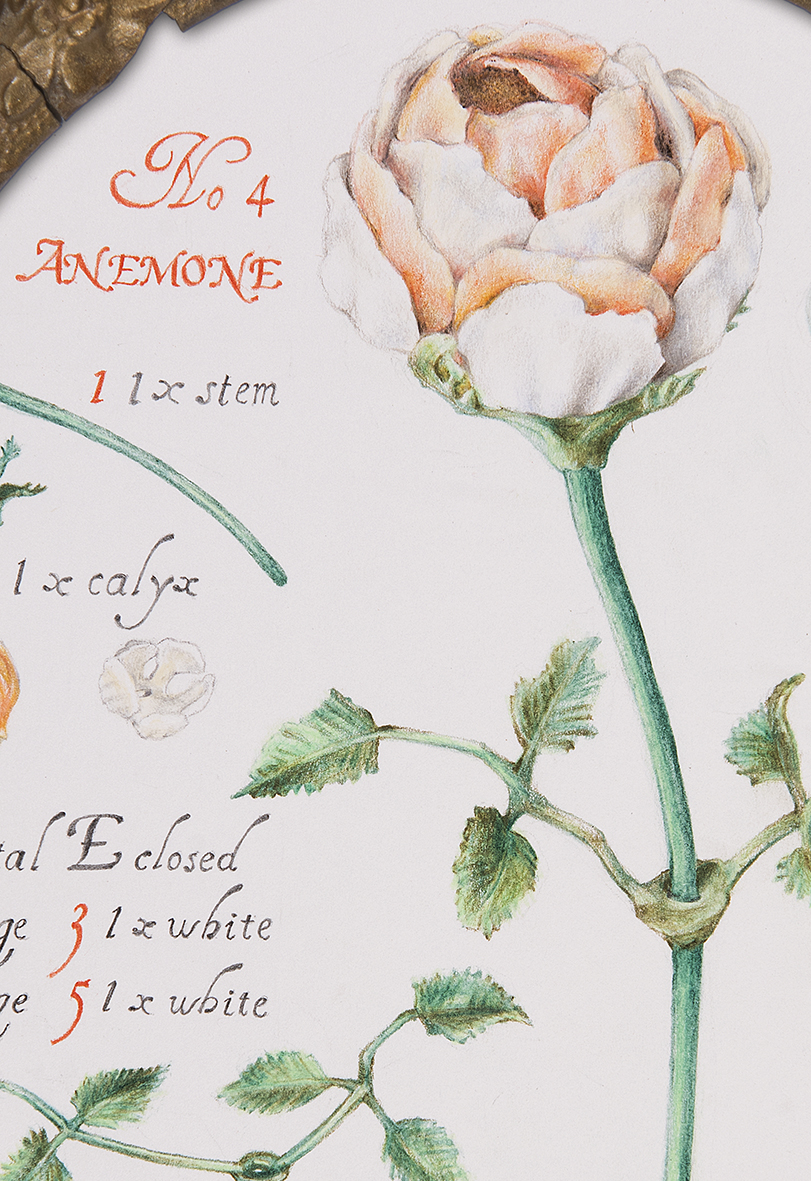 Flowerplay (Anemone)This is one of the few toy flowers based on real plants. I came across the folklore tale of fairies sleeping in the petals of anemone flowers at night, so I placed a fairy from my dolls' house alongside the Flower Play anemone for her to sleep in. She was a particular favourite of mine because I could re-shape her wings, she had a lovely embroidered skirt and her blue hair was iridescent (which I managed to capture with ink).
Flowerplay (Anemone)This is one of the few toy flowers based on real plants. I came across the folklore tale of fairies sleeping in the petals of anemone flowers at night, so I placed a fairy from my dolls' house alongside the Flower Play anemone for her to sleep in. She was a particular favourite of mine because I could re-shape her wings, she had a lovely embroidered skirt and her blue hair was iridescent (which I managed to capture with ink).
h:32.4cms x w:22.3cms (framed).
Cartridge paper
2012 -
 Flowerplay (Anemone)
Flowerplay (Anemone)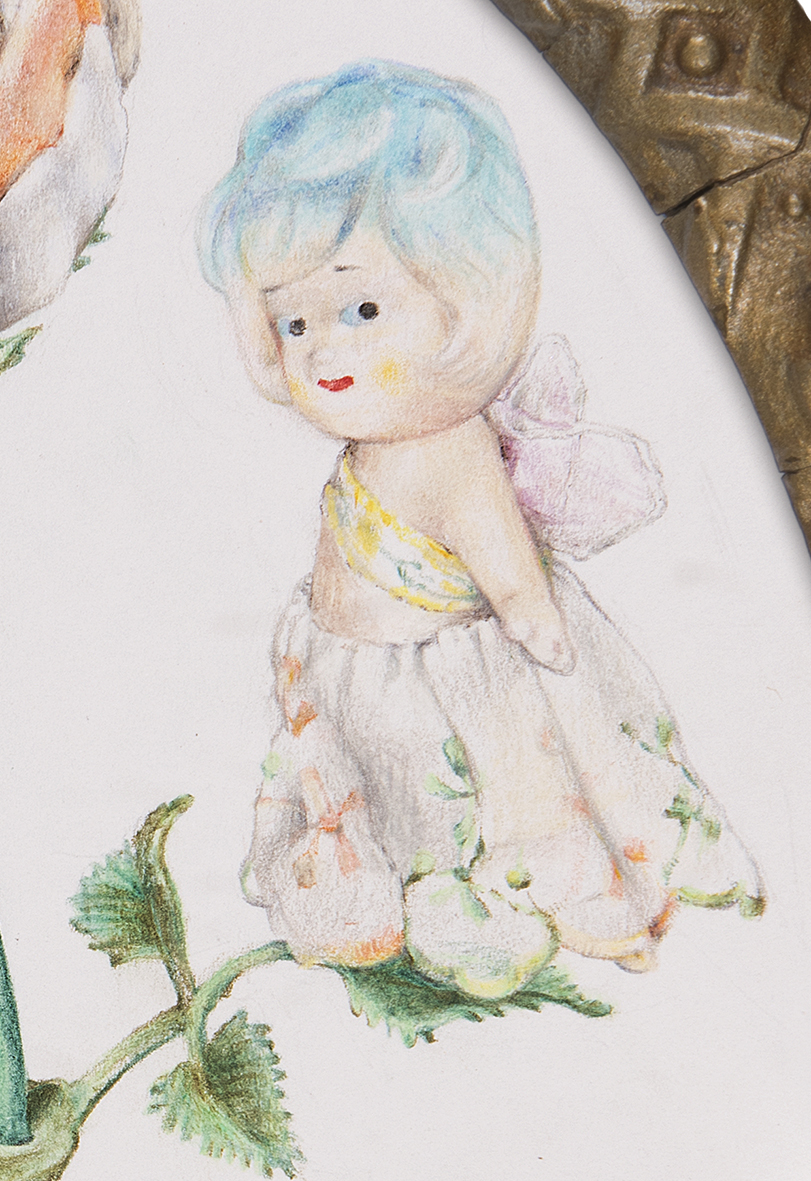 Flowerplay (Anemone)This is one of the few toy flowers based on real plants. I came across the folklore tale of fairies sleeping in the petals of anemone flowers at night, so I placed a fairy from my dolls' house alongside the Flower Play anemone for her to sleep in. She was a particular favourite of mine because I could re-shape her wings, she had a lovely embroidered skirt and her blue hair was iridescent (which I managed to capture with ink).
Flowerplay (Anemone)This is one of the few toy flowers based on real plants. I came across the folklore tale of fairies sleeping in the petals of anemone flowers at night, so I placed a fairy from my dolls' house alongside the Flower Play anemone for her to sleep in. She was a particular favourite of mine because I could re-shape her wings, she had a lovely embroidered skirt and her blue hair was iridescent (which I managed to capture with ink).
h:32.4cms x w:22.3cms (framed).
Cartridge paper
2012 -
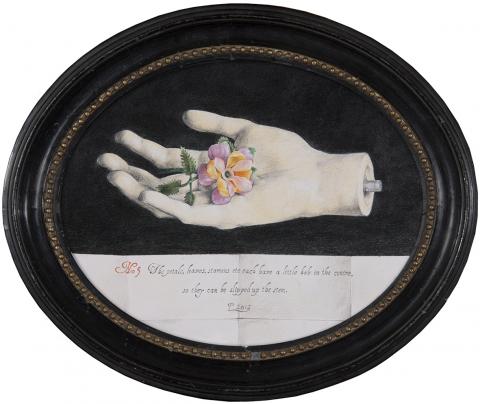 Flowerplay (They can be slipped up the stem)
Flowerplay (They can be slipped up the stem)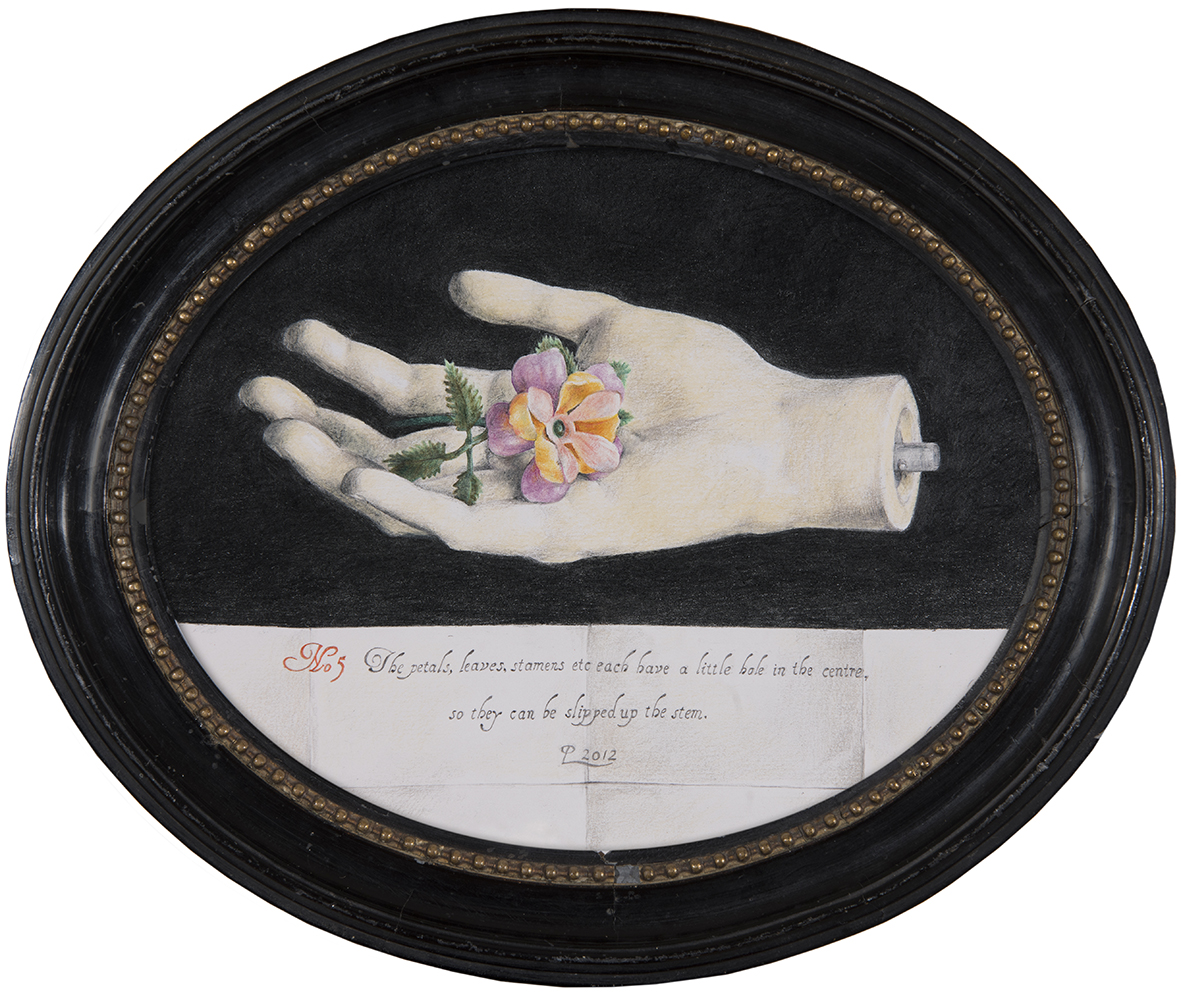 Flowerplay (They can be slipped up the stem)For this fifth drawing I combined a vintage mannequin's hand and this toy flower with the text on a trompe l'oeil piece of folded paper. I was thinking of the touch of a hand making these flowers, whilst referencing the Vanitas (brevity of life) imagery of 17th century Dutch still life painting.
Flowerplay (They can be slipped up the stem)For this fifth drawing I combined a vintage mannequin's hand and this toy flower with the text on a trompe l'oeil piece of folded paper. I was thinking of the touch of a hand making these flowers, whilst referencing the Vanitas (brevity of life) imagery of 17th century Dutch still life painting.
h:26cms x w:31.3cms (framed).
Coloured pencil on cartridge paper
2012 -
 Flowerplay (They can be slipped up the stem)
Flowerplay (They can be slipped up the stem)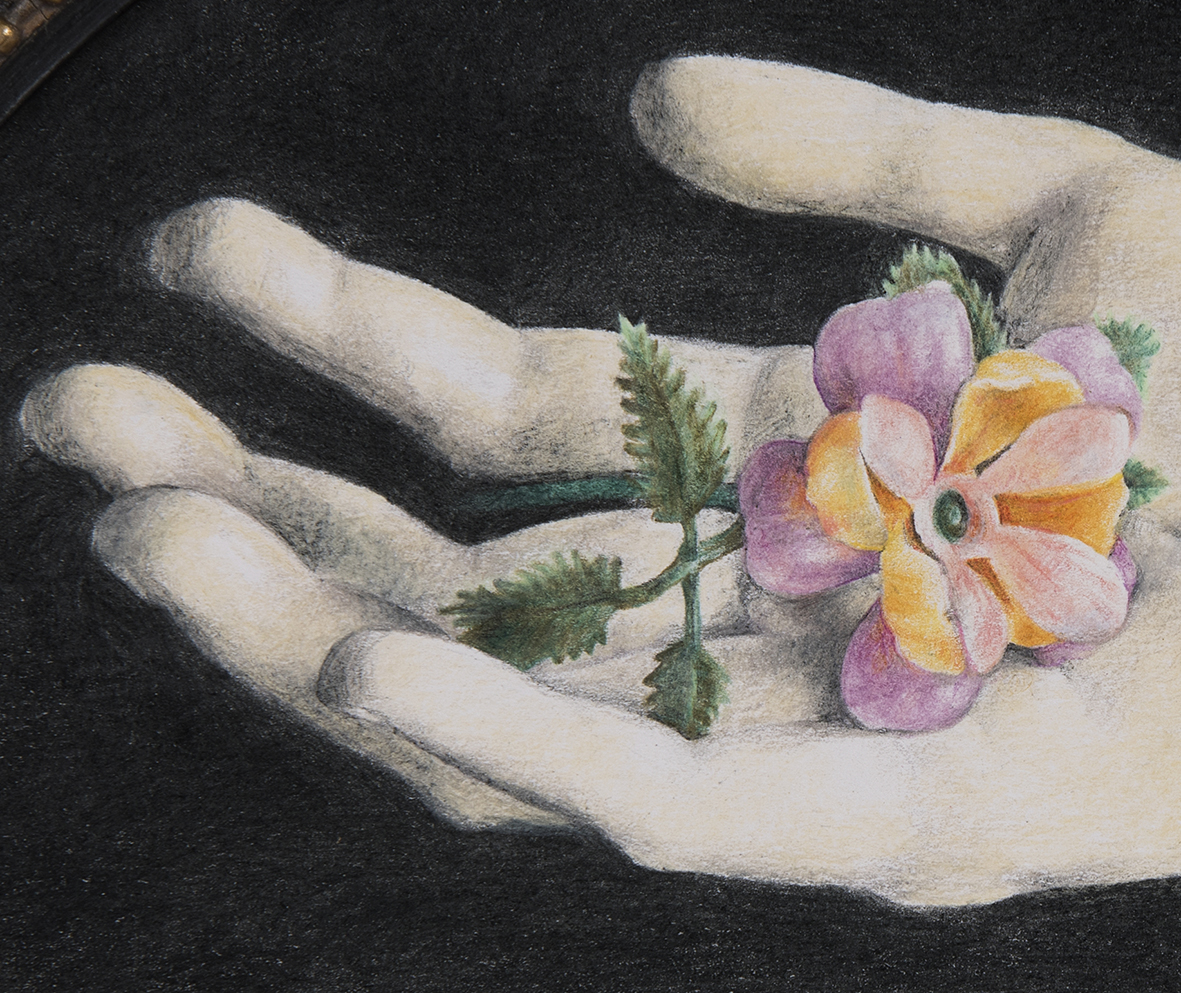 Flowerplay (They can be slipped up the stem)For this fifth drawing I combined a vintage mannequin's hand and this toy flower with the text on a trompe l'oeil piece of folded paper. I was thinking of the touch of a hand making these flowers, whilst referencing the Vanitas (brevity of life) imagery of 17th century Dutch still life painting.
Flowerplay (They can be slipped up the stem)For this fifth drawing I combined a vintage mannequin's hand and this toy flower with the text on a trompe l'oeil piece of folded paper. I was thinking of the touch of a hand making these flowers, whilst referencing the Vanitas (brevity of life) imagery of 17th century Dutch still life painting.
h:26cms x w:31.3cms (framed).
Coloured pencil on cartridge paper
2012 -
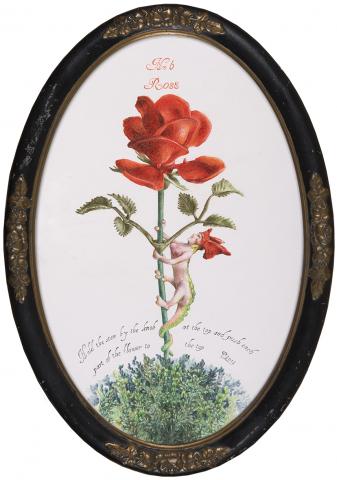 Flowerplay (Red rose)
Flowerplay (Red rose)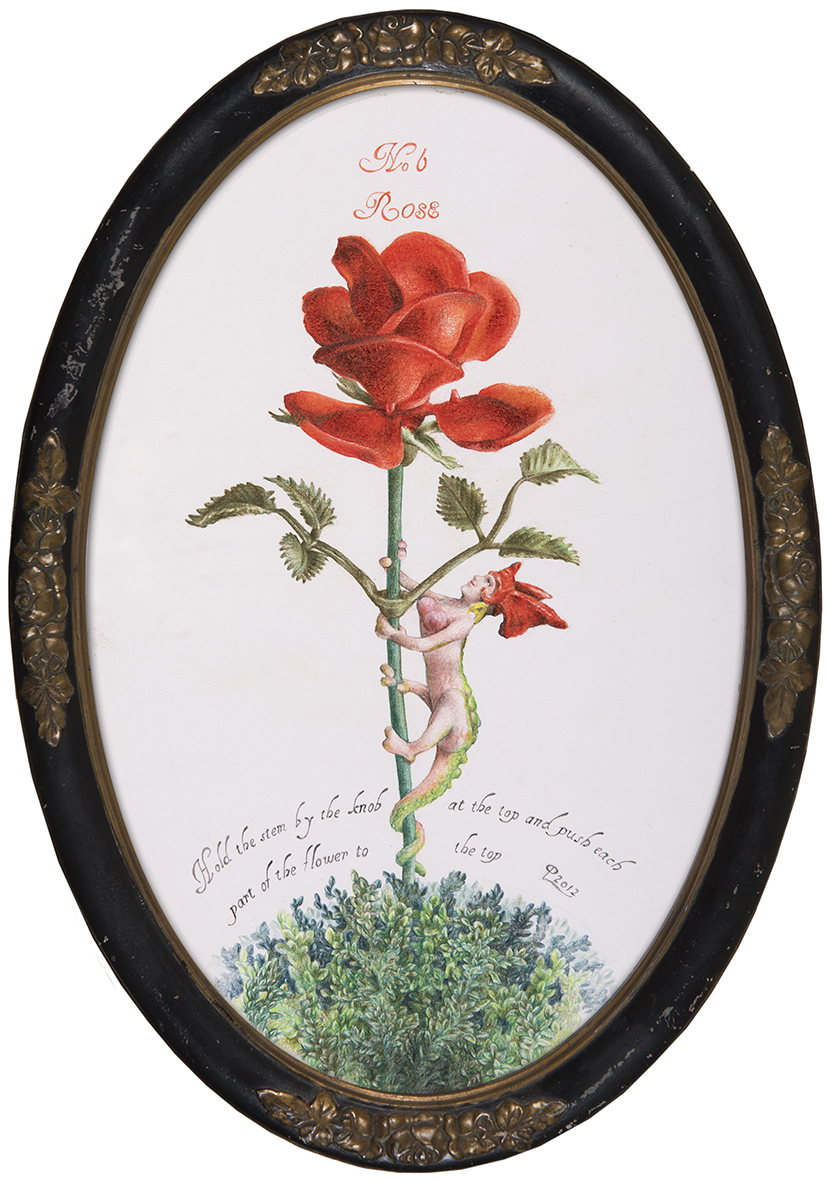 Flowerplay (Red rose)This is the sixth drawing and is one of the few flowers based on a real plant. The red rose in art is astonishingly rich in symbolism so I wanted to come up with a narrative of my own. In Atlanta, USA in 1996 while attending the opening of a group show I was involved in, I was given a little plastic mythical creature by a woman I didn't know: I have treasured it ever since. I don't know what character the toy was originally, but she seems to me to be part woman, lizard, goddess and warrior. She is making her way up the flower stem to claim her rose and all it represents in reality, imagination, dreams and nightmares.
Flowerplay (Red rose)This is the sixth drawing and is one of the few flowers based on a real plant. The red rose in art is astonishingly rich in symbolism so I wanted to come up with a narrative of my own. In Atlanta, USA in 1996 while attending the opening of a group show I was involved in, I was given a little plastic mythical creature by a woman I didn't know: I have treasured it ever since. I don't know what character the toy was originally, but she seems to me to be part woman, lizard, goddess and warrior. She is making her way up the flower stem to claim her rose and all it represents in reality, imagination, dreams and nightmares.
h:33.4cms x w:23.3cms (framed).
Coloured pencil on cartridge paper
2012 -
 Flowerplay (Red rose)
Flowerplay (Red rose)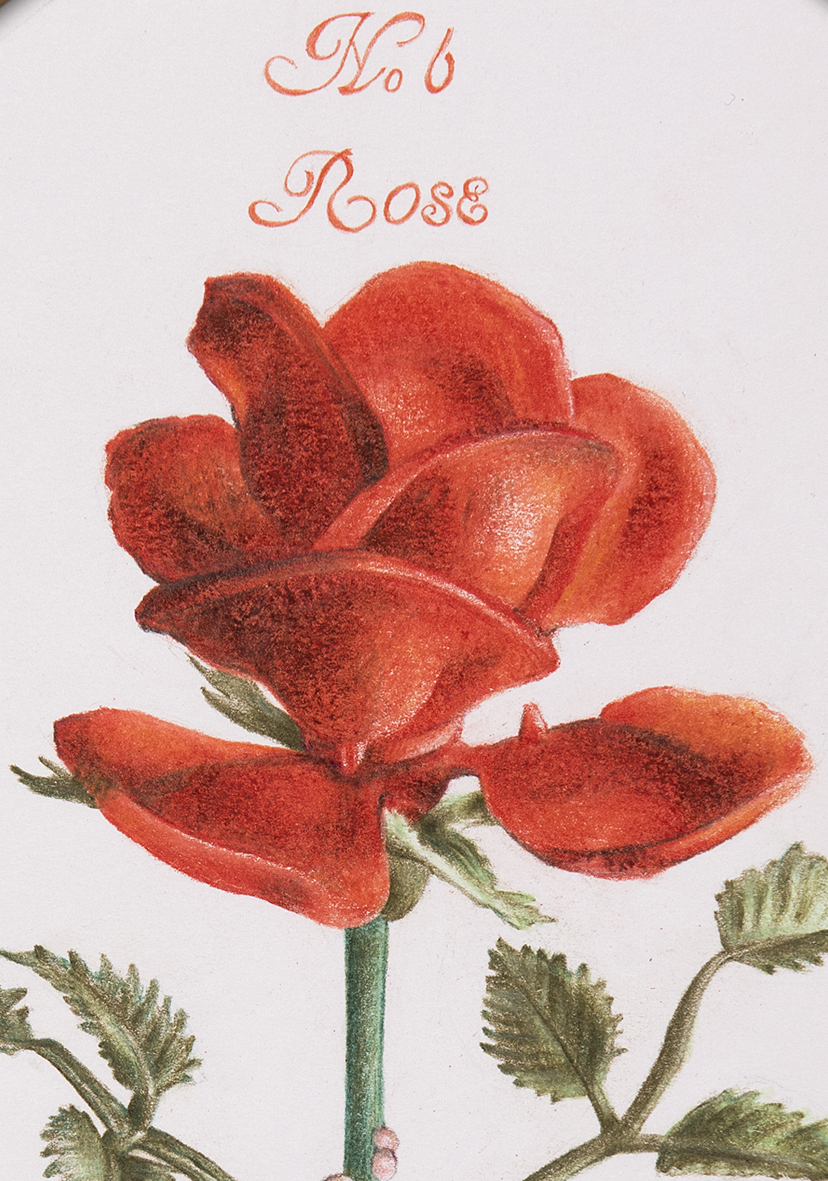 Flowerplay (Red rose)This is the sixth drawing and is one of the few flowers based on a real plant. The red rose in art is astonishingly rich in symbolism so I wanted to come up with a narrative of my own. In Atlanta, USA in 1996 while attending the opening of a group show I was involved in, I was given a little plastic mythical creature by a woman I didn't know: I have treasured it ever since. I don't know what character the toy was originally, but she seems to me to be part woman, lizard, goddess and warrior. She is making her way up the flower stem to claim her rose and all it represents in reality, imagination, dreams and nightmares.
Flowerplay (Red rose)This is the sixth drawing and is one of the few flowers based on a real plant. The red rose in art is astonishingly rich in symbolism so I wanted to come up with a narrative of my own. In Atlanta, USA in 1996 while attending the opening of a group show I was involved in, I was given a little plastic mythical creature by a woman I didn't know: I have treasured it ever since. I don't know what character the toy was originally, but she seems to me to be part woman, lizard, goddess and warrior. She is making her way up the flower stem to claim her rose and all it represents in reality, imagination, dreams and nightmares.
h:33.4cms x w:23.3cms (framed).
Coloured pencil on cartridge paper
2012 -
 Flowerplay (Red rose)
Flowerplay (Red rose)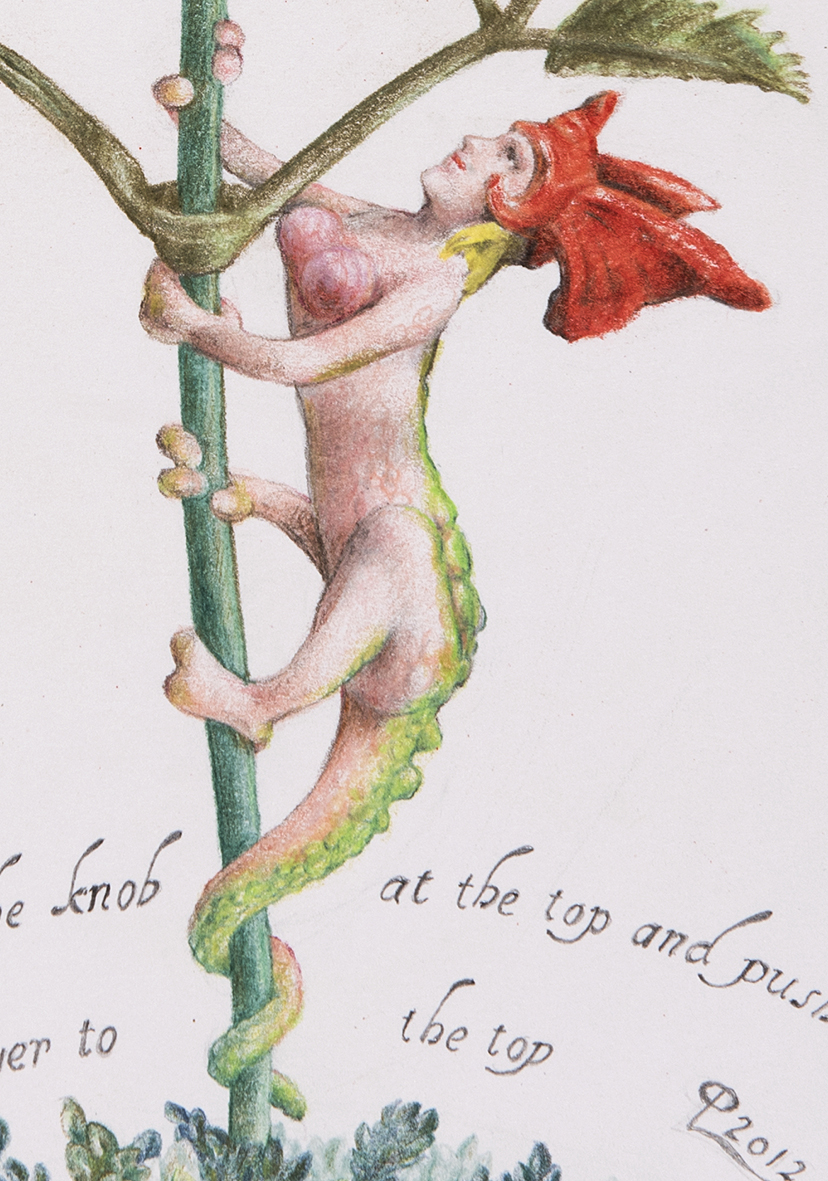 Flowerplay (Red rose)This is the sixth drawing and is one of the few flowers based on a real plant. The red rose in art is astonishingly rich in symbolism so I wanted to come up with a narrative of my own. In Atlanta, USA in 1996 while attending the opening of a group show I was involved in, I was given a little plastic mythical creature by a woman I didn't know: I have treasured it ever since. I don't know what character the toy was originally, but she seems to me to be part woman, lizard, goddess and warrior. She is making her way up the flower stem to claim her rose and all it represents in reality, imagination, dreams and nightmares.
Flowerplay (Red rose)This is the sixth drawing and is one of the few flowers based on a real plant. The red rose in art is astonishingly rich in symbolism so I wanted to come up with a narrative of my own. In Atlanta, USA in 1996 while attending the opening of a group show I was involved in, I was given a little plastic mythical creature by a woman I didn't know: I have treasured it ever since. I don't know what character the toy was originally, but she seems to me to be part woman, lizard, goddess and warrior. She is making her way up the flower stem to claim her rose and all it represents in reality, imagination, dreams and nightmares.
h:33.4cms x w:23.3cms (framed).
Coloured pencil on cartridge paper
2012 -
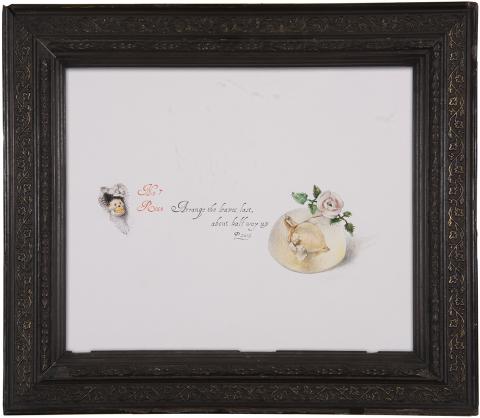 Flowerplay (White rose)
Flowerplay (White rose)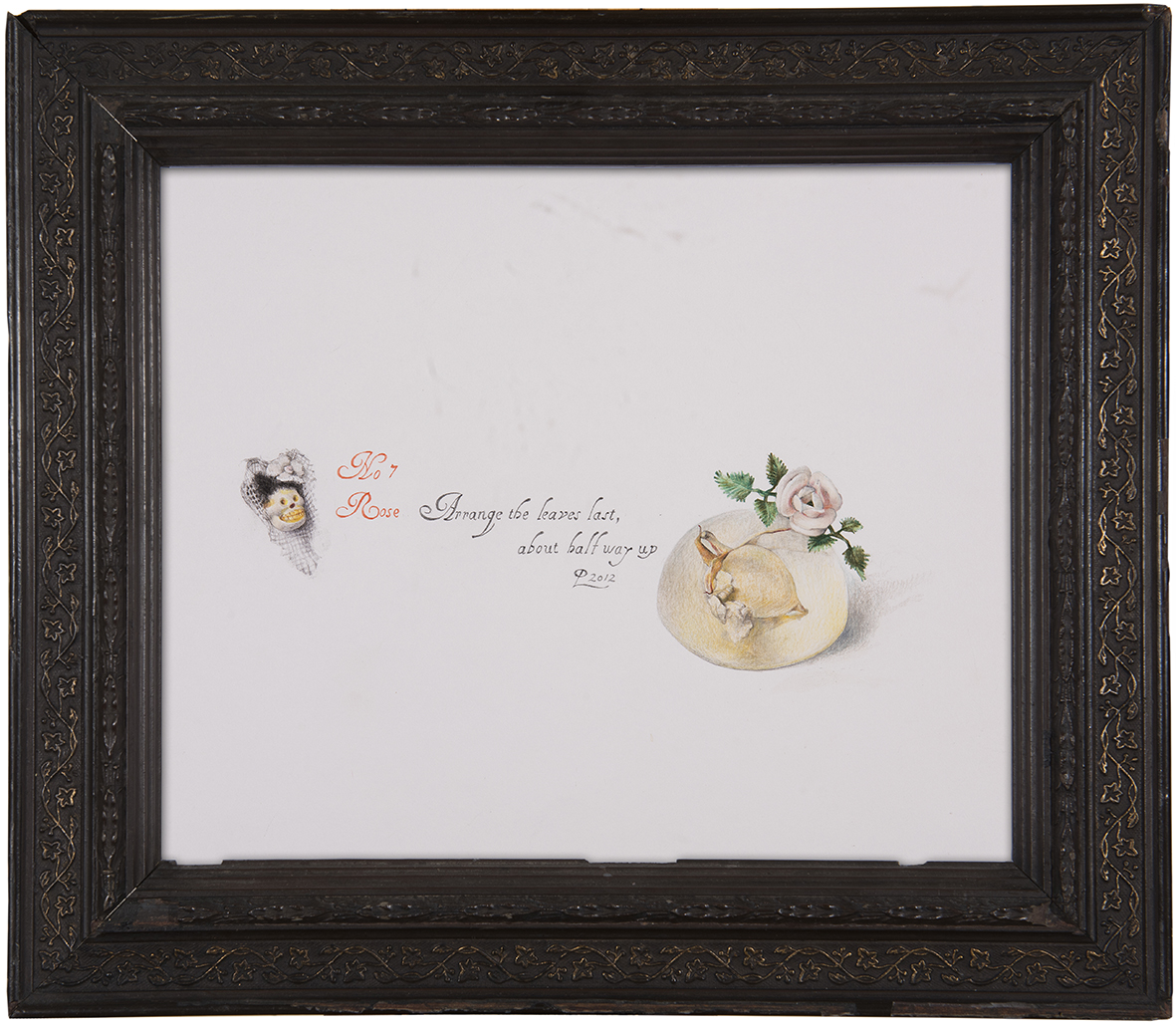 Flowerplay (White rose)This is the seventh drawing and the last of the toy flowers based on a real plant. The white rose is symbolically very rich in art and folklore so I have selected imagery that echoes some of these narratives, (a white bridal rose representing purity and innocence) but at the same time the imagery subverts this narrative. The toy rose rests on a white rose from my bridal bouquet that I tried to preserve in resin as a paperweight. However, the process went horribly wrong and, although I will never part with it, the rosebud now looks like something from Miss Haversham's story rather than a memento of my wonderful wedding day. I have also shown a bride Day of the Dead brooch made by a friend.
Flowerplay (White rose)This is the seventh drawing and the last of the toy flowers based on a real plant. The white rose is symbolically very rich in art and folklore so I have selected imagery that echoes some of these narratives, (a white bridal rose representing purity and innocence) but at the same time the imagery subverts this narrative. The toy rose rests on a white rose from my bridal bouquet that I tried to preserve in resin as a paperweight. However, the process went horribly wrong and, although I will never part with it, the rosebud now looks like something from Miss Haversham's story rather than a memento of my wonderful wedding day. I have also shown a bride Day of the Dead brooch made by a friend.
h:33.5cms x w:38.9cms (framed).
Coloured pencil on cartridge paper
2012 -
 Flowerplay (White rose)
Flowerplay (White rose)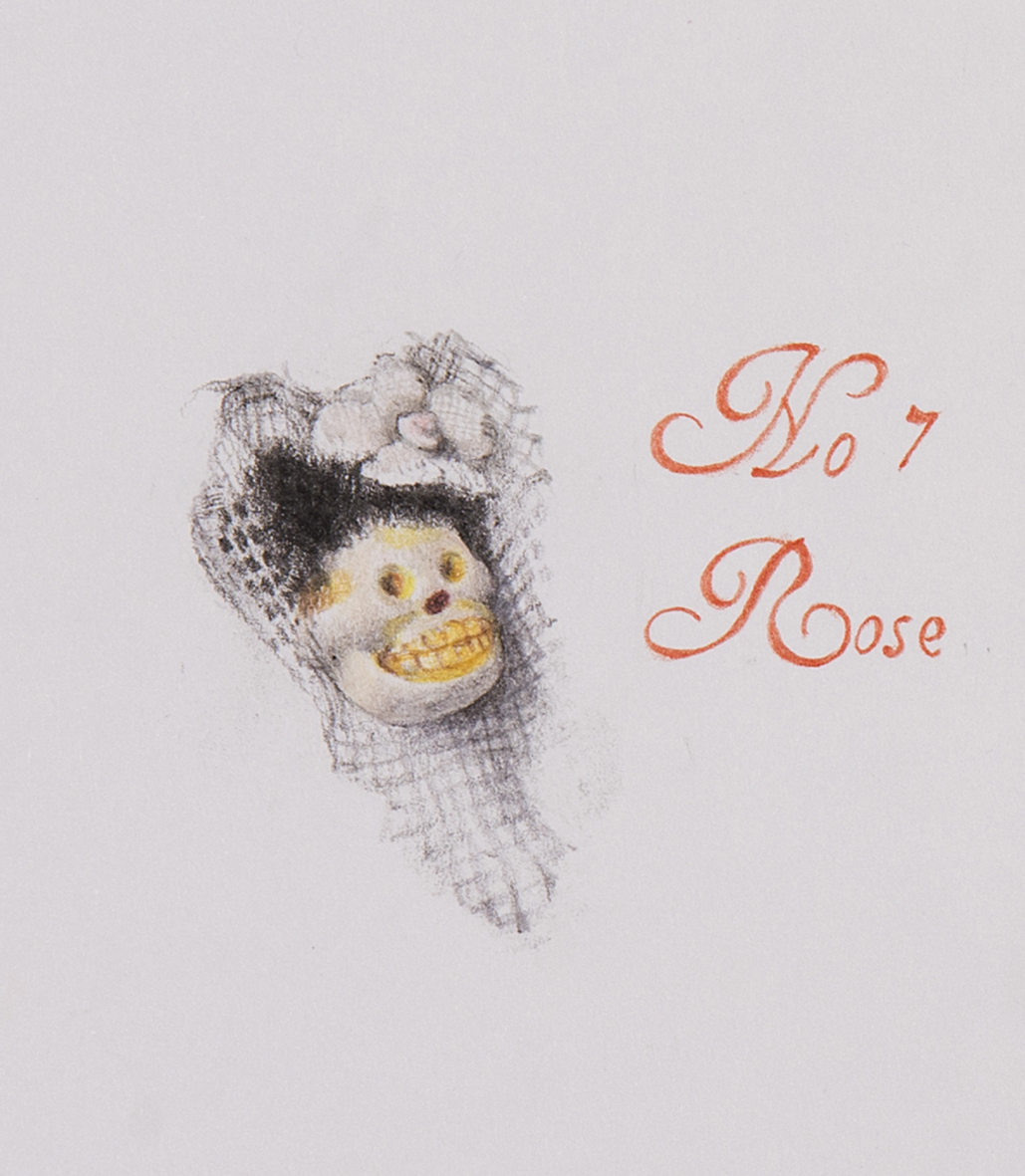 Flowerplay (White rose)This is the seventh drawing and the last of the toy flowers based on a real plant. The white rose is symbolically very rich in art and folklore so I have selected imagery that echoes some of these narratives, (a white bridal rose representing purity and innocence) but at the same time the imagery subverts this narrative. The toy rose rests on a white rose from my bridal bouquet that I tried to preserve in resin as a paperweight. However, the process went horribly wrong and, although I will never part with it, the rosebud now looks like something from Miss Haversham's story rather than a memento of my wonderful wedding day. I have also shown a bride Day of the Dead brooch made by a friend.
Flowerplay (White rose)This is the seventh drawing and the last of the toy flowers based on a real plant. The white rose is symbolically very rich in art and folklore so I have selected imagery that echoes some of these narratives, (a white bridal rose representing purity and innocence) but at the same time the imagery subverts this narrative. The toy rose rests on a white rose from my bridal bouquet that I tried to preserve in resin as a paperweight. However, the process went horribly wrong and, although I will never part with it, the rosebud now looks like something from Miss Haversham's story rather than a memento of my wonderful wedding day. I have also shown a bride Day of the Dead brooch made by a friend.
h:33.5cms x w:38.9cms (framed).
Coloured pencil on cartridge paper
2012 -
 Flowerplay (White rose)
Flowerplay (White rose)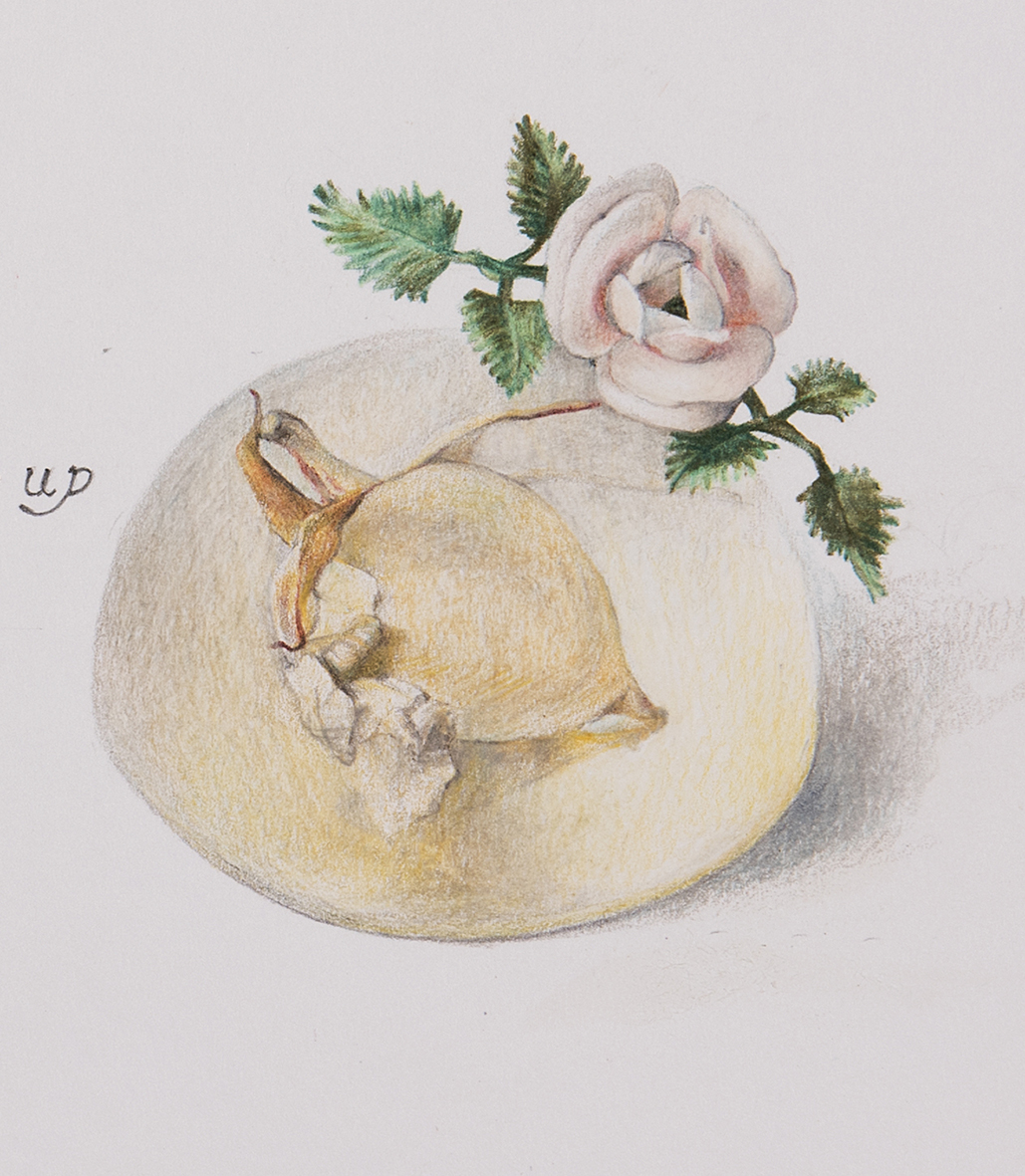 Flowerplay (White rose)This is the seventh drawing and the last of the toy flowers based on a real plant. The white rose is symbolically very rich in art and folklore so I have selected imagery that echoes some of these narratives, (a white bridal rose representing purity and innocence) but at the same time the imagery subverts this narrative. The toy rose rests on a white rose from my bridal bouquet that I tried to preserve in resin as a paperweight. However, the process went horribly wrong and, although I will never part with it, the rosebud now looks like something from Miss Haversham's story rather than a memento of my wonderful wedding day. I have also shown a bride Day of the Dead brooch made by a friend.
Flowerplay (White rose)This is the seventh drawing and the last of the toy flowers based on a real plant. The white rose is symbolically very rich in art and folklore so I have selected imagery that echoes some of these narratives, (a white bridal rose representing purity and innocence) but at the same time the imagery subverts this narrative. The toy rose rests on a white rose from my bridal bouquet that I tried to preserve in resin as a paperweight. However, the process went horribly wrong and, although I will never part with it, the rosebud now looks like something from Miss Haversham's story rather than a memento of my wonderful wedding day. I have also shown a bride Day of the Dead brooch made by a friend.
h:33.5cms x w:38.9cms (framed).
Coloured pencil on cartridge paper
2012 -
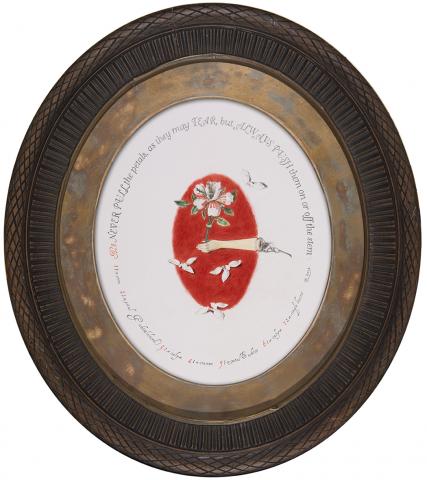 Flowerplay (Never pull the petals)
Flowerplay (Never pull the petals)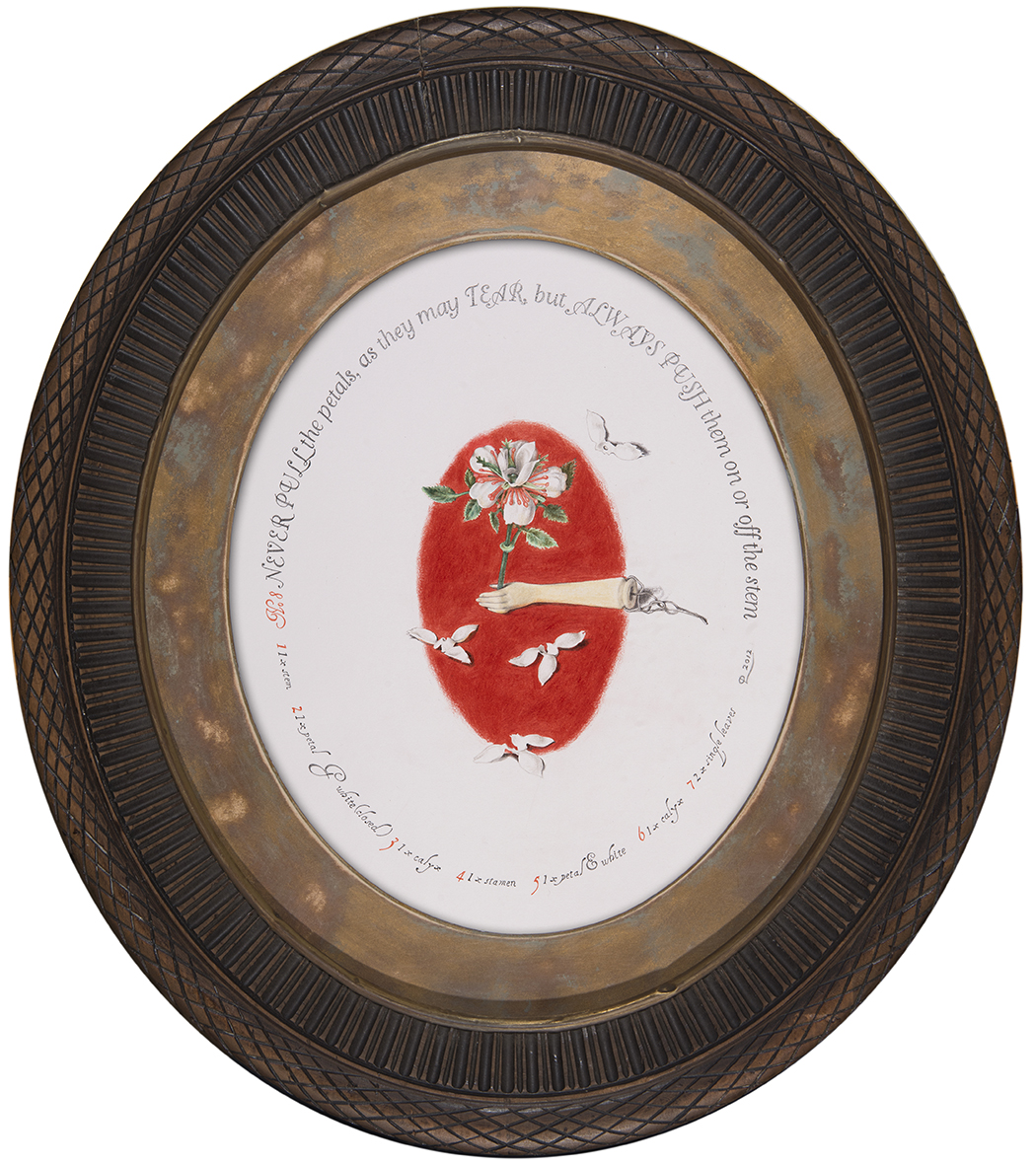 Flowerplay (Never pull the petals)This is the eighth drawing and was inspired by the instructions which caution against rough usage of the flower. The plastic flower parts now are extremely brittle and I was moved by their embodiment of the passage of time. Despite understanding plastic differently now that the havoc that it has wrought in the natural world is unavoidable, it does not alter the fact I have learned from and loved these plastic flowers for decades. I will never part with them and their delicacy reminds me of the care taken in handling real flower specimens. The flower represented is made according to the instructions and is surrounded by some of it's constituent petals which are broken and useless but there is one of the petals near the top which now looks like wings and makes me think of the flower's delicate fluttering soul. I used a detached hand from a boudoir doll which belonged to my grandmother to delicately hold the flower. The doll's arm is that of a young woman, not a child and this is intriguing within the context of girls' and women's relationship to flowers in the context of art and society.
Flowerplay (Never pull the petals)This is the eighth drawing and was inspired by the instructions which caution against rough usage of the flower. The plastic flower parts now are extremely brittle and I was moved by their embodiment of the passage of time. Despite understanding plastic differently now that the havoc that it has wrought in the natural world is unavoidable, it does not alter the fact I have learned from and loved these plastic flowers for decades. I will never part with them and their delicacy reminds me of the care taken in handling real flower specimens. The flower represented is made according to the instructions and is surrounded by some of it's constituent petals which are broken and useless but there is one of the petals near the top which now looks like wings and makes me think of the flower's delicate fluttering soul. I used a detached hand from a boudoir doll which belonged to my grandmother to delicately hold the flower. The doll's arm is that of a young woman, not a child and this is intriguing within the context of girls' and women's relationship to flowers in the context of art and society.
h:49.2cms x w:43.4cms (framed).
Coloured pencil on cartridge paper
2012 -
 Flowerplay (Never pull the petals)
Flowerplay (Never pull the petals)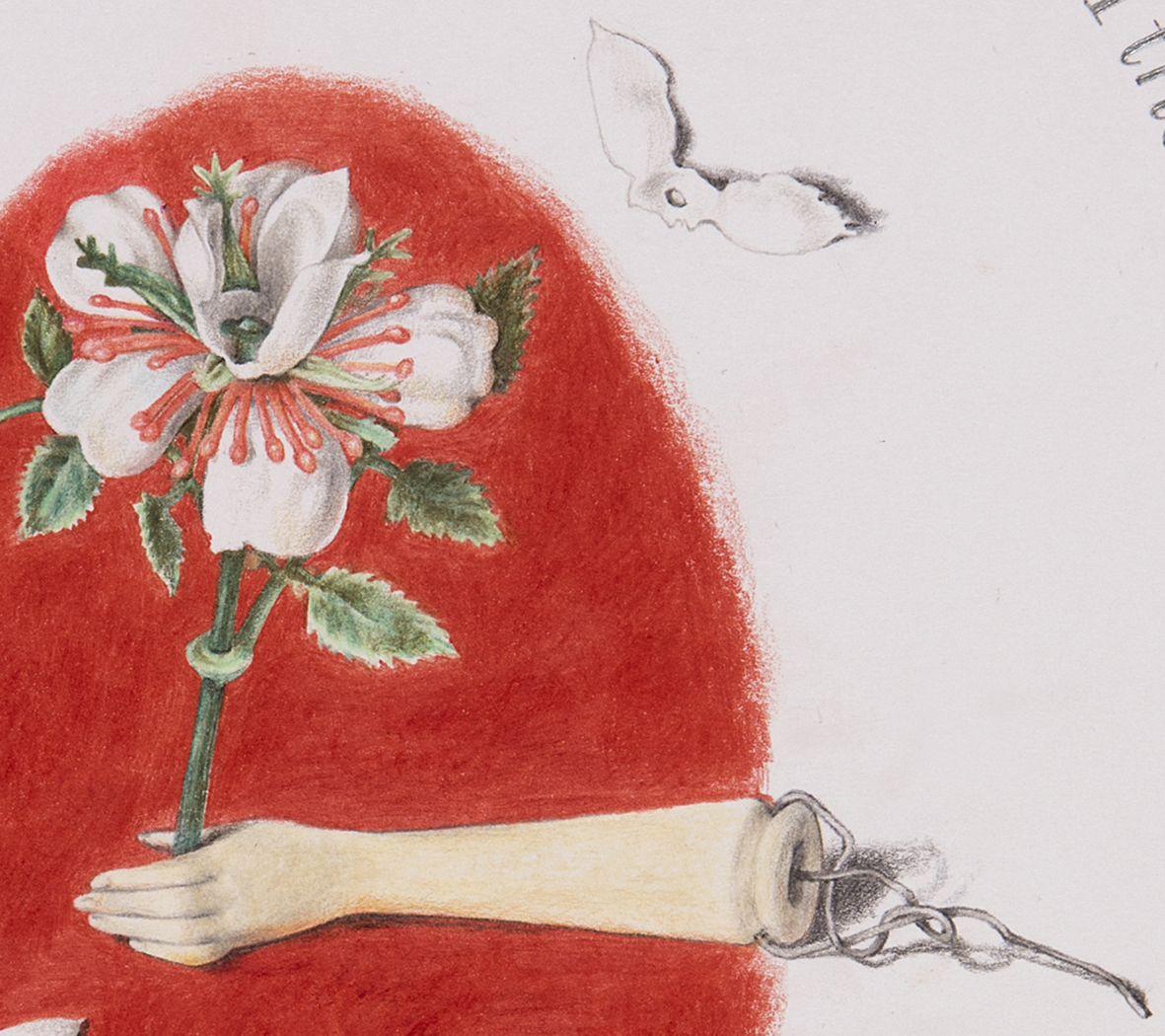 Flowerplay (Never pull the petals)This is the eighth drawing and was inspired by the instructions which caution against rough usage of the flower. The plastic flower parts now are extremely brittle and I was moved by their embodiment of the passage of time. Despite understanding plastic differently now that the havoc that it has wrought in the natural world is unavoidable, it does not alter the fact I have learned from and loved these plastic flowers for decades. I will never part with them and their delicacy reminds me of the care taken in handling real flower specimens. The flower represented is made according to the instructions and is surrounded by some of it's constituent petals which are broken and useless but there is one of the petals near the top which now looks like wings and makes me think of the flower's delicate fluttering soul. I used a detached hand from a boudoir doll which belonged to my grandmother to delicately hold the flower. The doll's arm is that of a young woman, not a child and this is intriguing within the context of girls' and women's relationship to flowers in the context of art and society.
Flowerplay (Never pull the petals)This is the eighth drawing and was inspired by the instructions which caution against rough usage of the flower. The plastic flower parts now are extremely brittle and I was moved by their embodiment of the passage of time. Despite understanding plastic differently now that the havoc that it has wrought in the natural world is unavoidable, it does not alter the fact I have learned from and loved these plastic flowers for decades. I will never part with them and their delicacy reminds me of the care taken in handling real flower specimens. The flower represented is made according to the instructions and is surrounded by some of it's constituent petals which are broken and useless but there is one of the petals near the top which now looks like wings and makes me think of the flower's delicate fluttering soul. I used a detached hand from a boudoir doll which belonged to my grandmother to delicately hold the flower. The doll's arm is that of a young woman, not a child and this is intriguing within the context of girls' and women's relationship to flowers in the context of art and society.
h:49.2cms x w:43.4cms (framed).
Coloured pencil on cartridge paper
2012 -
 Flowerplay (Never pull the petals)
Flowerplay (Never pull the petals)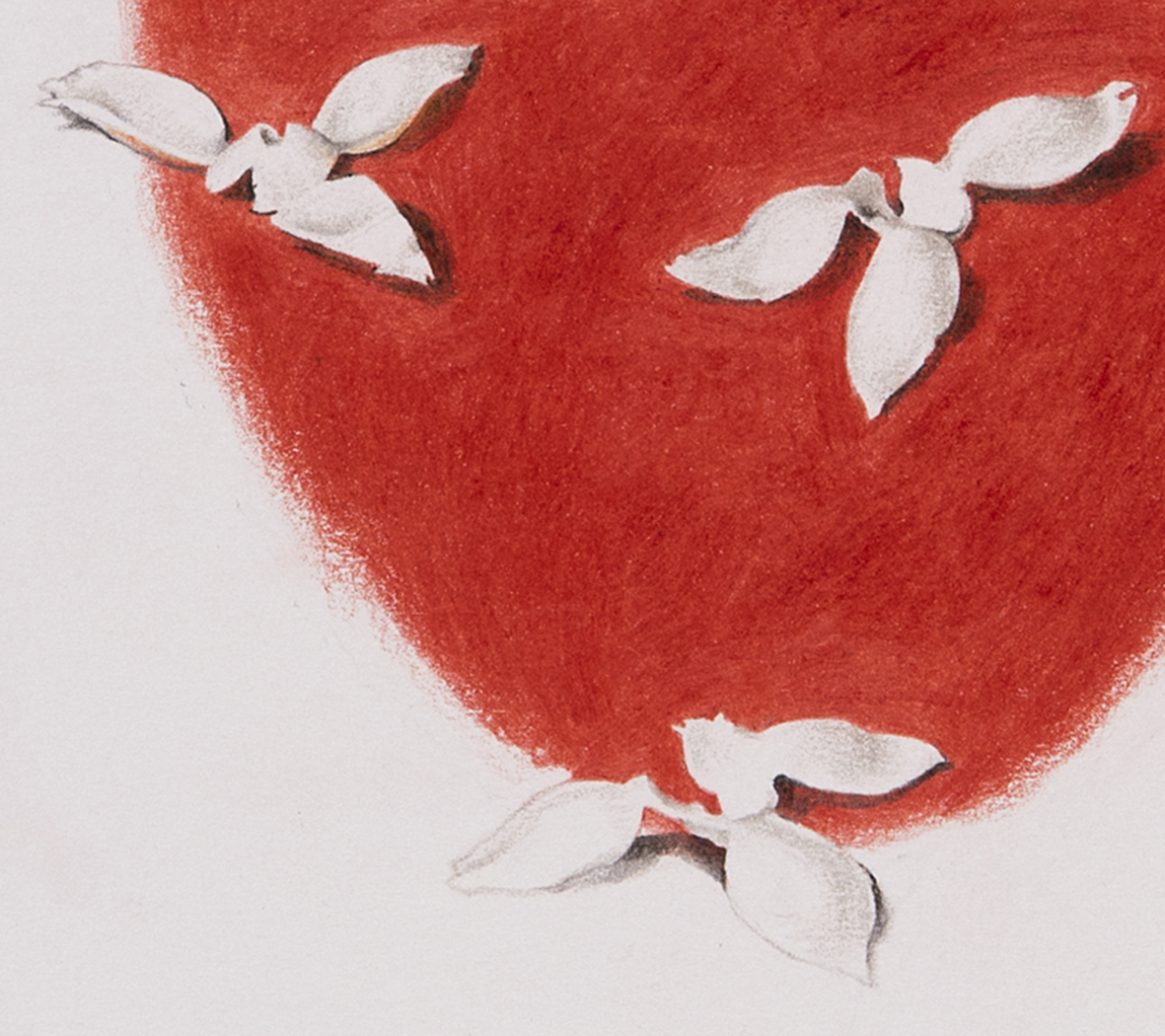 Flowerplay (Never pull the petals)This is the eighth drawing and was inspired by the instructions which caution against rough usage of the flower. The plastic flower parts now are extremely brittle and I was moved by their embodiment of the passage of time. Despite understanding plastic differently now that the havoc that it has wrought in the natural world is unavoidable, it does not alter the fact I have learned from and loved these plastic flowers for decades. I will never part with them and their delicacy reminds me of the care taken in handling real flower specimens. The flower represented is made according to the instructions and is surrounded by some of it's constituent petals which are broken and useless but there is one of the petals near the top which now looks like wings and makes me think of the flower's delicate fluttering soul. I used a detached hand from a boudoir doll which belonged to my grandmother to delicately hold the flower. The doll's arm is that of a young woman, not a child and this is intriguing within the context of girls' and women's relationship to flowers in the context of art and society.
Flowerplay (Never pull the petals)This is the eighth drawing and was inspired by the instructions which caution against rough usage of the flower. The plastic flower parts now are extremely brittle and I was moved by their embodiment of the passage of time. Despite understanding plastic differently now that the havoc that it has wrought in the natural world is unavoidable, it does not alter the fact I have learned from and loved these plastic flowers for decades. I will never part with them and their delicacy reminds me of the care taken in handling real flower specimens. The flower represented is made according to the instructions and is surrounded by some of it's constituent petals which are broken and useless but there is one of the petals near the top which now looks like wings and makes me think of the flower's delicate fluttering soul. I used a detached hand from a boudoir doll which belonged to my grandmother to delicately hold the flower. The doll's arm is that of a young woman, not a child and this is intriguing within the context of girls' and women's relationship to flowers in the context of art and society.
h:49.2cms x w:43.4cms (framed).
Coloured pencil on cartridge paper
2012 -
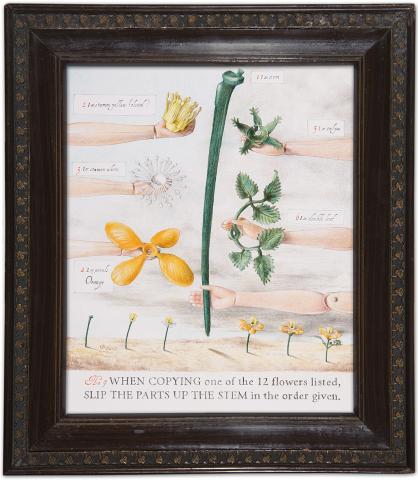 Flowerplay (In the order given)
Flowerplay (In the order given)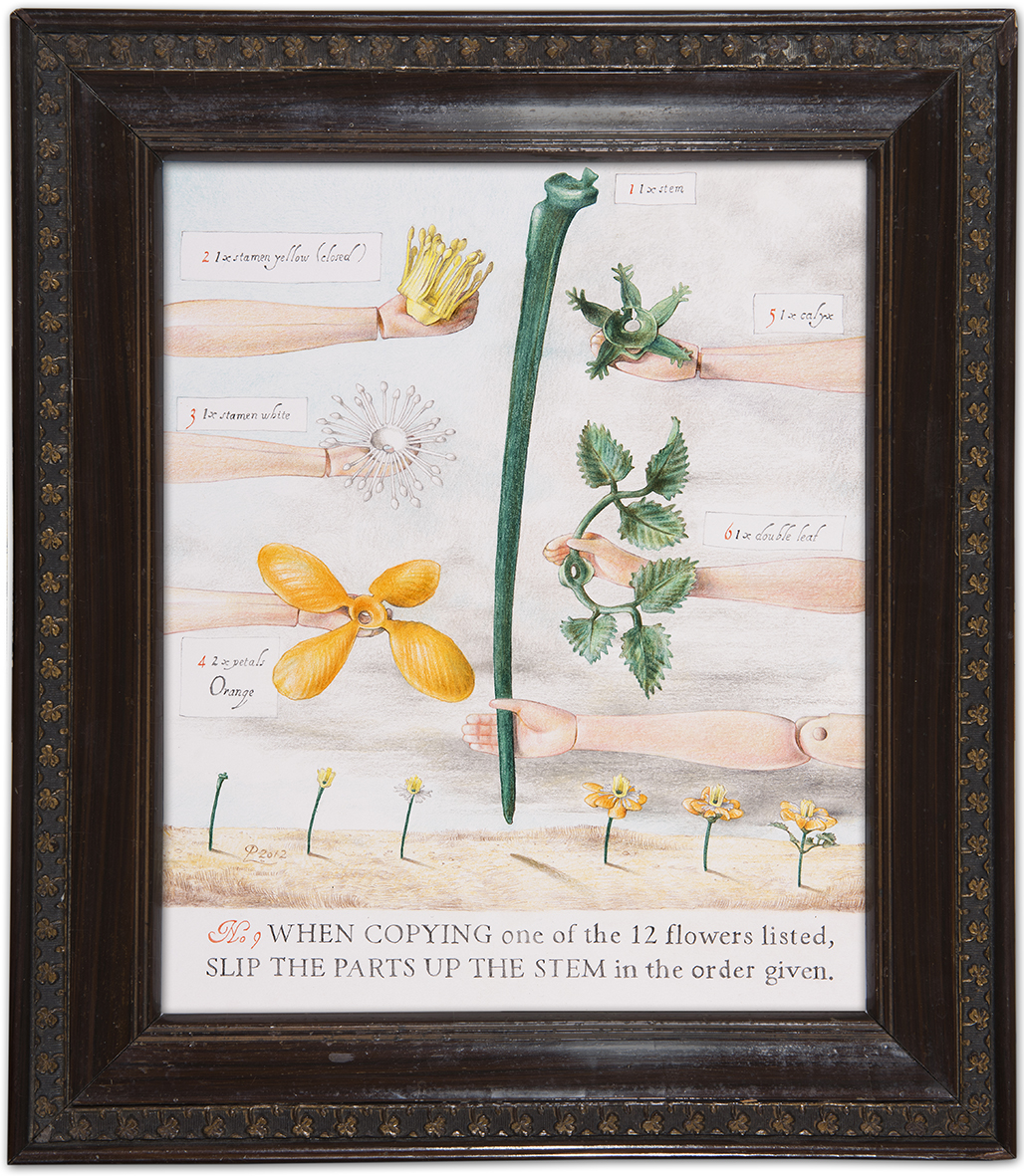 Flowerplay (In the order given)This is the ninth drawing in the Flower Play series: I wanted to create an ambiguous image exploring the rigidity of some of the assembly instructions. I used an arm of a Pippa doll I had as a child and put each of the parts of the flower as directed in order of assembly in her hand. I had been looking at the extraordinary images in Robert Thornton's book 'A Temple of Flora' (1807) and was captivated by the intensely unsettling atmosphere in the illustrations. I tried to capture this by combining dissonant scales, a concentrated focus on the arm and flower parts, a lowering sky and the flower illustrated in its various stages of assembly underneath.
Flowerplay (In the order given)This is the ninth drawing in the Flower Play series: I wanted to create an ambiguous image exploring the rigidity of some of the assembly instructions. I used an arm of a Pippa doll I had as a child and put each of the parts of the flower as directed in order of assembly in her hand. I had been looking at the extraordinary images in Robert Thornton's book 'A Temple of Flora' (1807) and was captivated by the intensely unsettling atmosphere in the illustrations. I tried to capture this by combining dissonant scales, a concentrated focus on the arm and flower parts, a lowering sky and the flower illustrated in its various stages of assembly underneath.
h:38.5cms x w:33.2cms (framed).
Coloured pencil on cartridge paper
2012 -
 Flowerplay (In the order given)
Flowerplay (In the order given)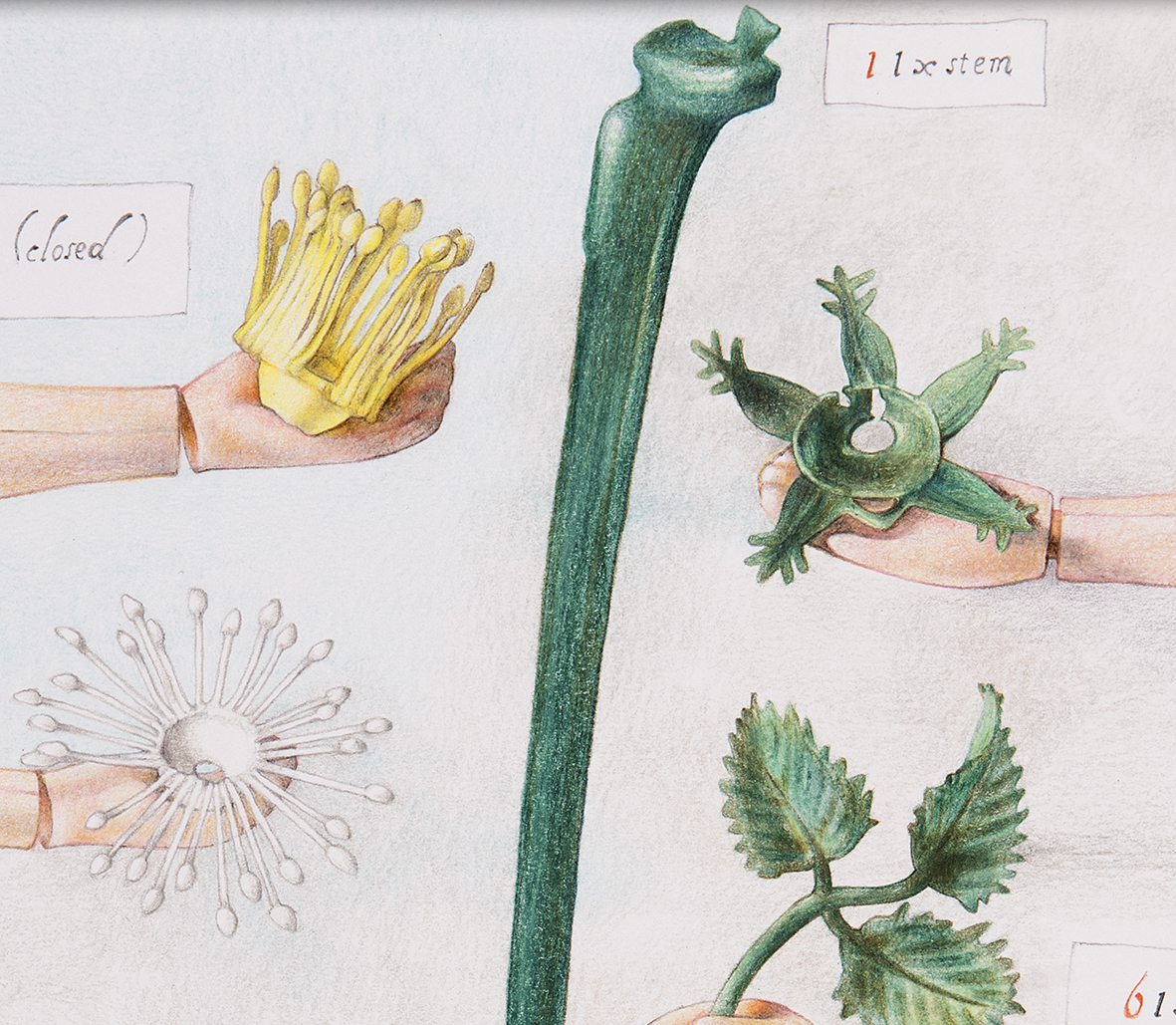 Flowerplay (In the order given)This is the ninth drawing in the Flower Play series: I wanted to create an ambiguous image exploring the rigidity of some of the assembly instructions. I used an arm of a Pippa doll I had as a child and put each of the parts of the flower as directed in order of assembly in her hand. I had been looking at the extraordinary images in Robert Thornton's book 'A Temple of Flora' (1807) and was captivated by the intensely unsettling atmosphere in the illustrations. I tried to capture this by combining dissonant scales, a concentrated focus on the arm and flower parts, a lowering sky and the flower illustrated in its various stages of assembly underneath.
Flowerplay (In the order given)This is the ninth drawing in the Flower Play series: I wanted to create an ambiguous image exploring the rigidity of some of the assembly instructions. I used an arm of a Pippa doll I had as a child and put each of the parts of the flower as directed in order of assembly in her hand. I had been looking at the extraordinary images in Robert Thornton's book 'A Temple of Flora' (1807) and was captivated by the intensely unsettling atmosphere in the illustrations. I tried to capture this by combining dissonant scales, a concentrated focus on the arm and flower parts, a lowering sky and the flower illustrated in its various stages of assembly underneath.
h:38.5cms x w:33.2cms (framed).
Coloured pencil on cartridge paper
2012 -
 Flowerplay (In the order given)
Flowerplay (In the order given)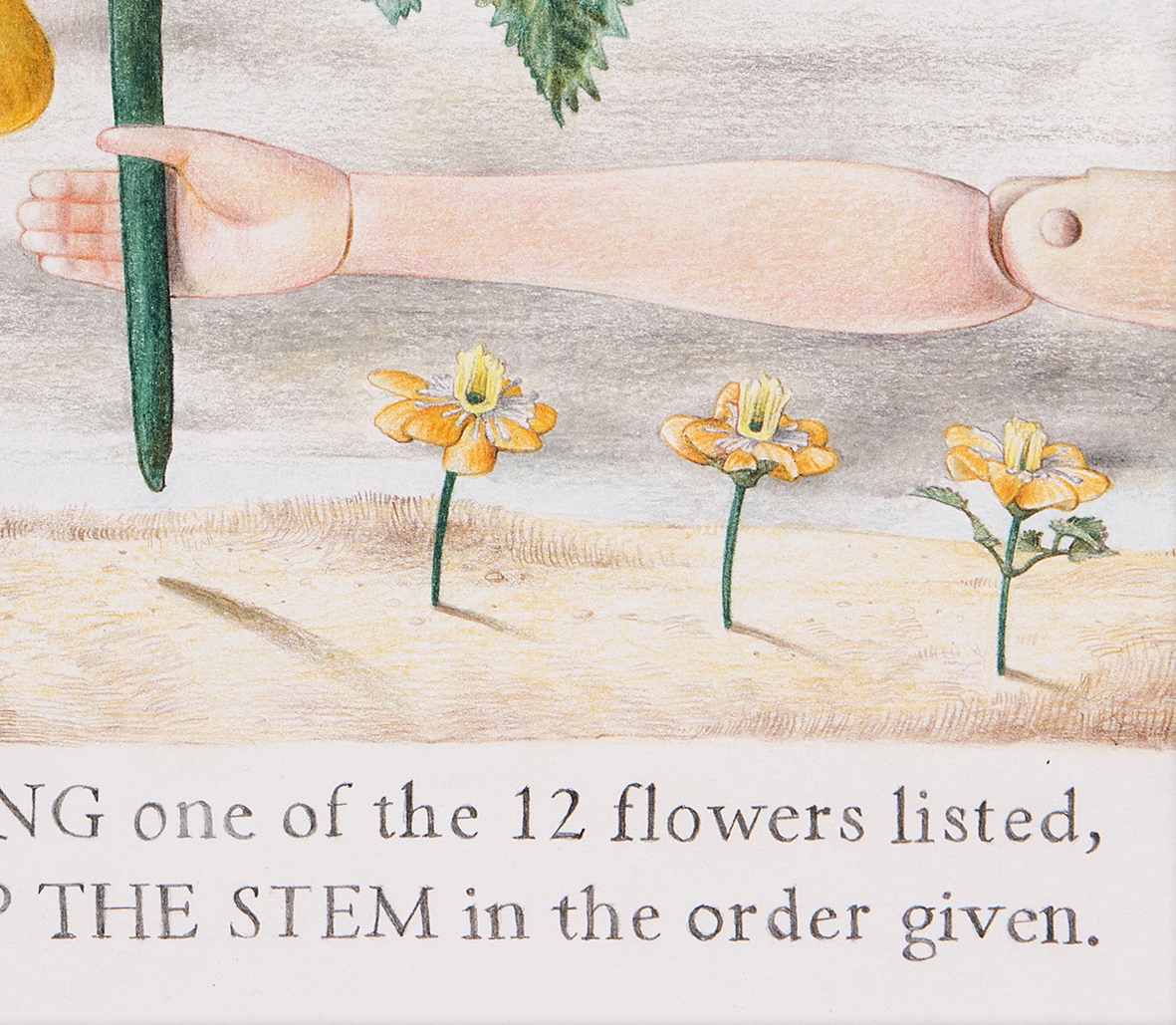 Flowerplay (In the order given)This is the ninth drawing in the Flower Play series: I wanted to create an ambiguous image exploring the rigidity of some of the assembly instructions. I used an arm of a Pippa doll I had as a child and put each of the parts of the flower as directed in order of assembly in her hand. I had been looking at the extraordinary images in Robert Thornton's book 'A Temple of Flora' (1807) and was captivated by the intensely unsettling atmosphere in the illustrations. I tried to capture this by combining dissonant scales, a concentrated focus on the arm and flower parts, a lowering sky and the flower illustrated in its various stages of assembly underneath.
Flowerplay (In the order given)This is the ninth drawing in the Flower Play series: I wanted to create an ambiguous image exploring the rigidity of some of the assembly instructions. I used an arm of a Pippa doll I had as a child and put each of the parts of the flower as directed in order of assembly in her hand. I had been looking at the extraordinary images in Robert Thornton's book 'A Temple of Flora' (1807) and was captivated by the intensely unsettling atmosphere in the illustrations. I tried to capture this by combining dissonant scales, a concentrated focus on the arm and flower parts, a lowering sky and the flower illustrated in its various stages of assembly underneath.
h:38.5cms x w:33.2cms (framed).
Coloured pencil on cartridge paper
2012 -
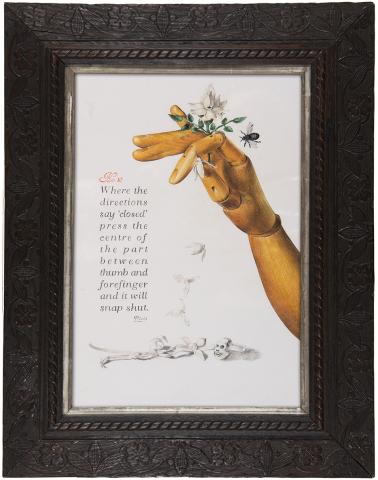 Flowerplay (Between the thumb and forefinger)
Flowerplay (Between the thumb and forefinger)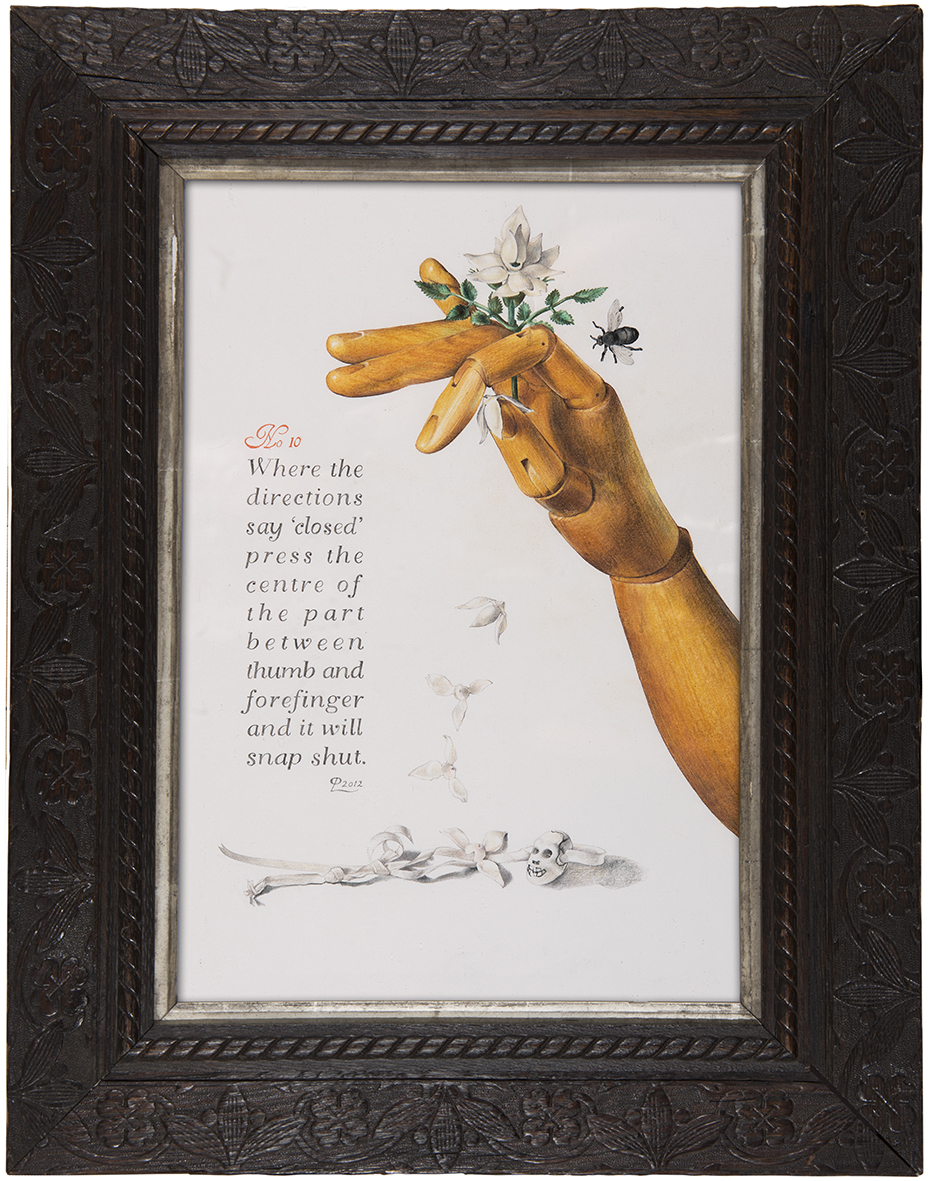 Flowerplay (Between the thumb and forefinger)Many years ago my mother (who was also an artist) bought a vintage glove display stand which features some beautifully articulated wooden hands on a metal stand. The delicacy of the movement referred to in the instructions, combined with the now brittle fragility of the plastic flower parts and the fairy tale threat of the 'snap shut' text inspired this tenth drawing. I placed the flower in the wooden hand and put the petals between its fingers as instructed. The petals fall down initially shut but then open again as they descend. The last petal is open and broken and lies on the skeleton-like ribbon threaded through a day of the dead skull bead which I have had for so long it's origins are forgotten. The plastic fly at the top of the drawing completes the 'Vanites" and "Memento Mori' (brevity of life) symbolism.
Flowerplay (Between the thumb and forefinger)Many years ago my mother (who was also an artist) bought a vintage glove display stand which features some beautifully articulated wooden hands on a metal stand. The delicacy of the movement referred to in the instructions, combined with the now brittle fragility of the plastic flower parts and the fairy tale threat of the 'snap shut' text inspired this tenth drawing. I placed the flower in the wooden hand and put the petals between its fingers as instructed. The petals fall down initially shut but then open again as they descend. The last petal is open and broken and lies on the skeleton-like ribbon threaded through a day of the dead skull bead which I have had for so long it's origins are forgotten. The plastic fly at the top of the drawing completes the 'Vanites" and "Memento Mori' (brevity of life) symbolism.
h:50.2cms x w:39.3cms (framed).
Coloured pencil on cartridge paper
2012 -
 Flowerplay (Between the thumb and forefinger)
Flowerplay (Between the thumb and forefinger)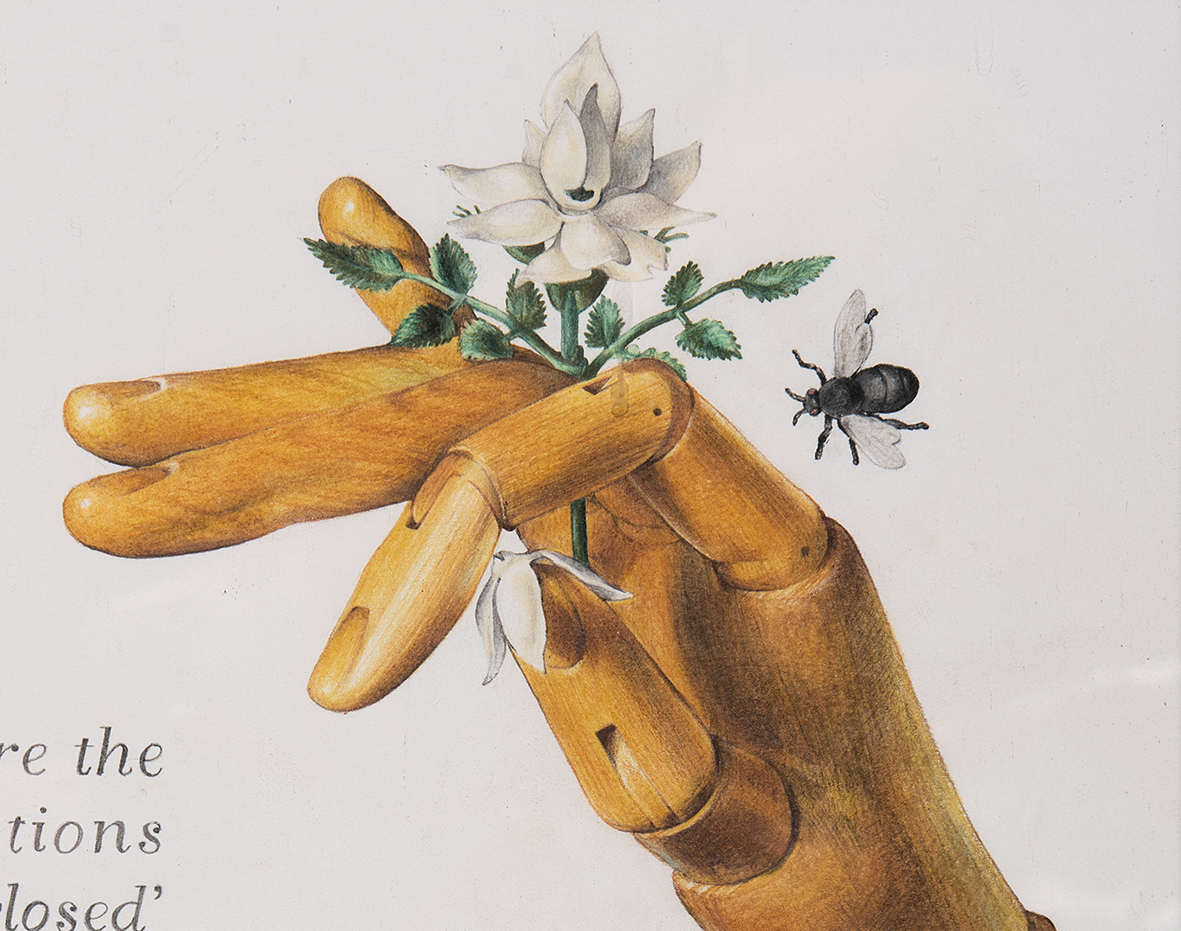 Flowerplay (Between the thumb and forefinger)Many years ago my mother (who was also an artist) bought a vintage glove display stand which features some beautifully articulated wooden hands on a metal stand. The delicacy of the movement referred to in the instructions, combined with the now brittle fragility of the plastic flower parts and the fairy tale threat of the 'snap shut' text inspired this tenth drawing. I placed the flower in the wooden hand and put the petals between its fingers as instructed. The petals fall down initially shut but then open again as they descend. The last petal is open and broken and lies on the skeleton-like ribbon threaded through a day of the dead skull bead which I have had for so long it's origins are forgotten. The plastic fly at the top of the drawing completes the 'Vanites" and "Memento Mori' (brevity of life) symbolism.
Flowerplay (Between the thumb and forefinger)Many years ago my mother (who was also an artist) bought a vintage glove display stand which features some beautifully articulated wooden hands on a metal stand. The delicacy of the movement referred to in the instructions, combined with the now brittle fragility of the plastic flower parts and the fairy tale threat of the 'snap shut' text inspired this tenth drawing. I placed the flower in the wooden hand and put the petals between its fingers as instructed. The petals fall down initially shut but then open again as they descend. The last petal is open and broken and lies on the skeleton-like ribbon threaded through a day of the dead skull bead which I have had for so long it's origins are forgotten. The plastic fly at the top of the drawing completes the 'Vanites" and "Memento Mori' (brevity of life) symbolism.
h:50.2cms x w:39.3cms (framed).
Coloured pencil on cartridge paper
2012 -
 Flowerplay (Between the thumb and forefinger)
Flowerplay (Between the thumb and forefinger)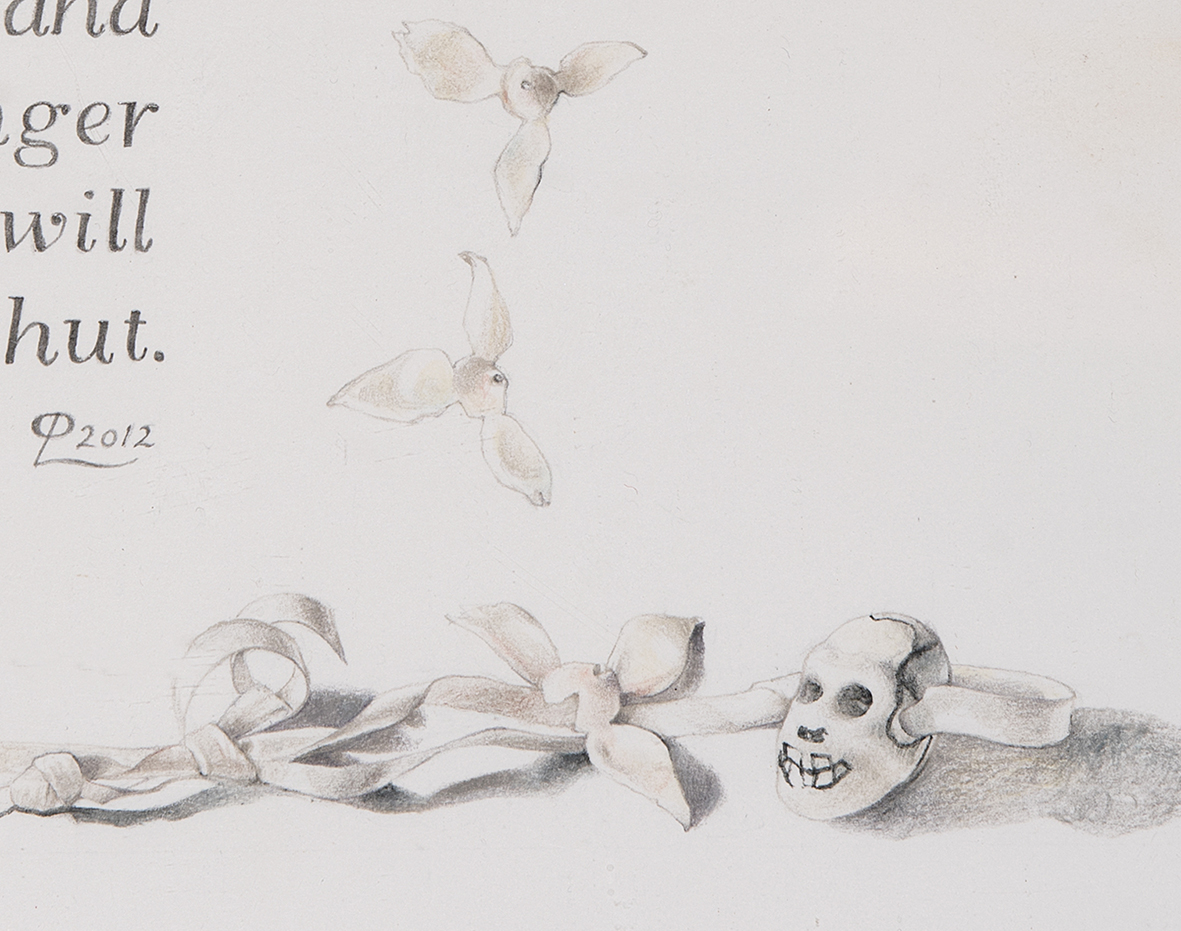 Flowerplay (Between the thumb and forefinger)Many years ago my mother (who was also an artist) bought a vintage glove display stand which features some beautifully articulated wooden hands on a metal stand. The delicacy of the movement referred to in the instructions, combined with the now brittle fragility of the plastic flower parts and the fairy tale threat of the 'snap shut' text inspired this tenth drawing. I placed the flower in the wooden hand and put the petals between its fingers as instructed. The petals fall down initially shut but then open again as they descend. The last petal is open and broken and lies on the skeleton-like ribbon threaded through a day of the dead skull bead which I have had for so long it's origins are forgotten. The plastic fly at the top of the drawing completes the 'Vanites" and "Memento Mori' (brevity of life) symbolism.
Flowerplay (Between the thumb and forefinger)Many years ago my mother (who was also an artist) bought a vintage glove display stand which features some beautifully articulated wooden hands on a metal stand. The delicacy of the movement referred to in the instructions, combined with the now brittle fragility of the plastic flower parts and the fairy tale threat of the 'snap shut' text inspired this tenth drawing. I placed the flower in the wooden hand and put the petals between its fingers as instructed. The petals fall down initially shut but then open again as they descend. The last petal is open and broken and lies on the skeleton-like ribbon threaded through a day of the dead skull bead which I have had for so long it's origins are forgotten. The plastic fly at the top of the drawing completes the 'Vanites" and "Memento Mori' (brevity of life) symbolism.
h:50.2cms x w:39.3cms (framed).
Coloured pencil on cartridge paper
2012 -
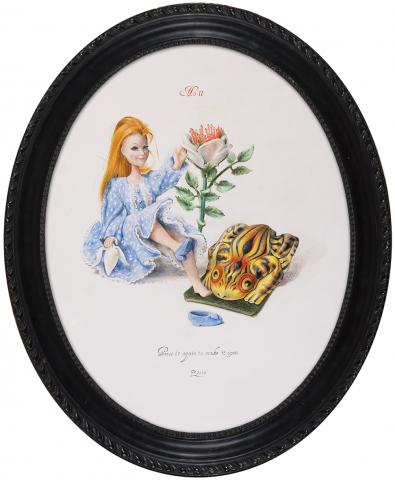 Flowerplay (Press it again to make it open)
Flowerplay (Press it again to make it open)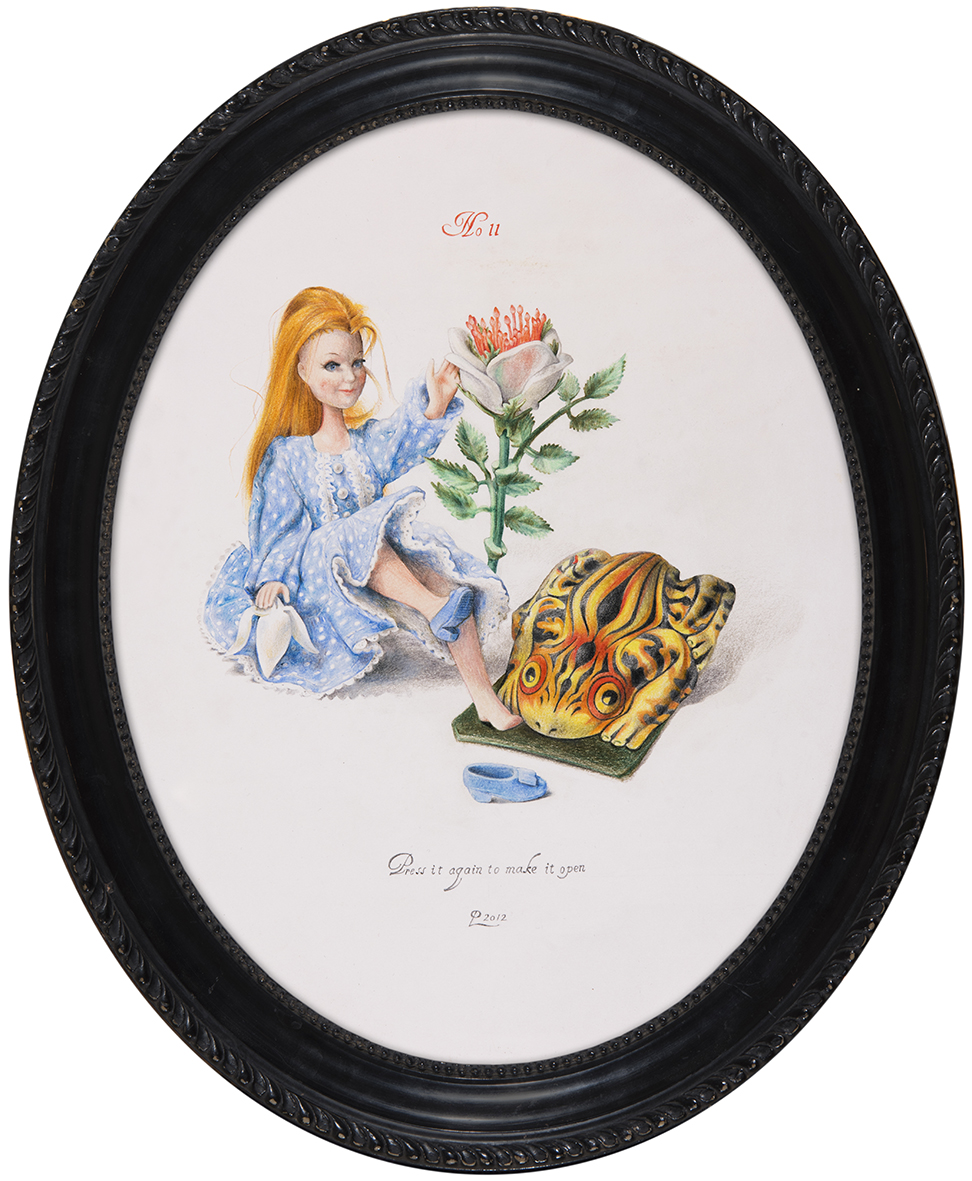 Flowerplay (Press it again to make it open)This eleventh drawing was inspired by the instruction text '...press it again to make it open...'. I wanted to explore imagery suggesting the innocent play of girl hood combined with the awareness of female adolesence and young adulthood. Perhaps this drawing is a warning from my older to my younger self? My favourite red haired Pippa doll rests one hand on the flower and the other on it's closed petals. She has lifted one leg and kicked off a shoe as she rests her naked foot next to a frog. This is a tin frog that I think my grandparents brought back from Hong Kong around 1935: it makes a very loud and sharp 'snapping' noise when you press it down onto its base. There are many interpretations of the symbolism of frogs in art (for example, as witches' familiars, fertility or transformation): each of which , and more, could apply here. I always have the imagery of one my favourite artists (Paula Rego) and writers (Angela Carter) in the back of my mind: but I think they came to the fore in this drawing.
Flowerplay (Press it again to make it open)This eleventh drawing was inspired by the instruction text '...press it again to make it open...'. I wanted to explore imagery suggesting the innocent play of girl hood combined with the awareness of female adolesence and young adulthood. Perhaps this drawing is a warning from my older to my younger self? My favourite red haired Pippa doll rests one hand on the flower and the other on it's closed petals. She has lifted one leg and kicked off a shoe as she rests her naked foot next to a frog. This is a tin frog that I think my grandparents brought back from Hong Kong around 1935: it makes a very loud and sharp 'snapping' noise when you press it down onto its base. There are many interpretations of the symbolism of frogs in art (for example, as witches' familiars, fertility or transformation): each of which , and more, could apply here. I always have the imagery of one my favourite artists (Paula Rego) and writers (Angela Carter) in the back of my mind: but I think they came to the fore in this drawing.
h:44cms x w:36cms (framed).
Coloured pencil on cartridge paper
2012 -
 Flowerplay (Press it again to make it open)
Flowerplay (Press it again to make it open)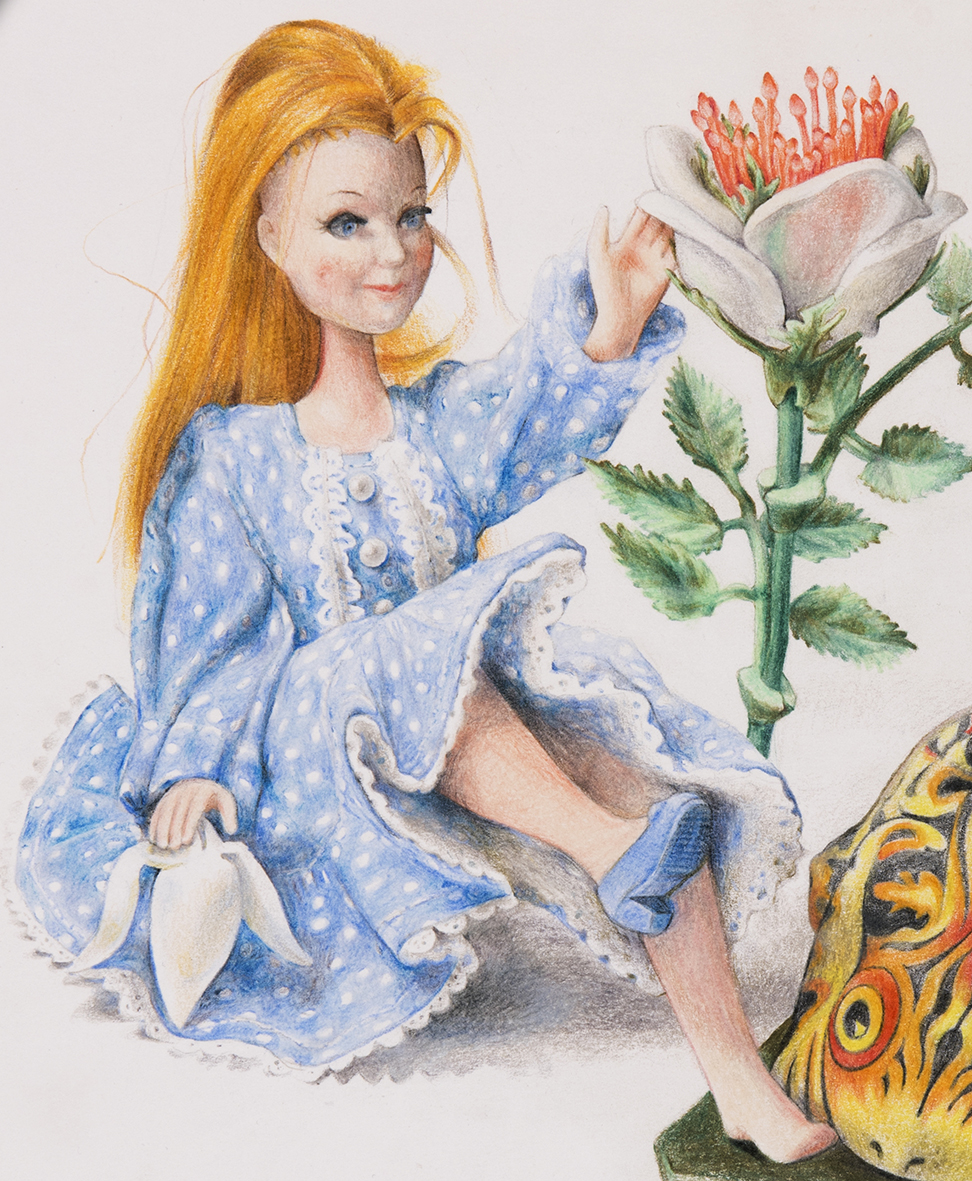 Flowerplay (Press it again to make it open)This eleventh drawing was inspired by the instruction text '...press it again to make it open...'. I wanted to explore imagery suggesting the innocent play of girl hood combined with the awareness of female adolesence and young adulthood. Perhaps this drawing is a warning from my older to my younger self? My favourite red haired Pippa doll rests one hand on the flower and the other on it's closed petals. She has lifted one leg and kicked off a shoe as she rests her naked foot next to a frog. This is a tin frog that I think my grandparents brought back from Hong Kong around 1935: it makes a very loud and sharp 'snapping' noise when you press it down onto its base. There are many interpretations of the symbolism of frogs in art (for example, as witches' familiars, fertility or transformation): each of which , and more, could apply here. I always have the imagery of one my favourite artists (Paula Rego) and writers (Angela Carter) in the back of my mind: but I think they came to the fore in this drawing.
Flowerplay (Press it again to make it open)This eleventh drawing was inspired by the instruction text '...press it again to make it open...'. I wanted to explore imagery suggesting the innocent play of girl hood combined with the awareness of female adolesence and young adulthood. Perhaps this drawing is a warning from my older to my younger self? My favourite red haired Pippa doll rests one hand on the flower and the other on it's closed petals. She has lifted one leg and kicked off a shoe as she rests her naked foot next to a frog. This is a tin frog that I think my grandparents brought back from Hong Kong around 1935: it makes a very loud and sharp 'snapping' noise when you press it down onto its base. There are many interpretations of the symbolism of frogs in art (for example, as witches' familiars, fertility or transformation): each of which , and more, could apply here. I always have the imagery of one my favourite artists (Paula Rego) and writers (Angela Carter) in the back of my mind: but I think they came to the fore in this drawing.
h:44cms x w:36cms (framed).
Coloured pencil on cartridge paper
2012 -
 Flowerplay (Press it again to make it open)
Flowerplay (Press it again to make it open)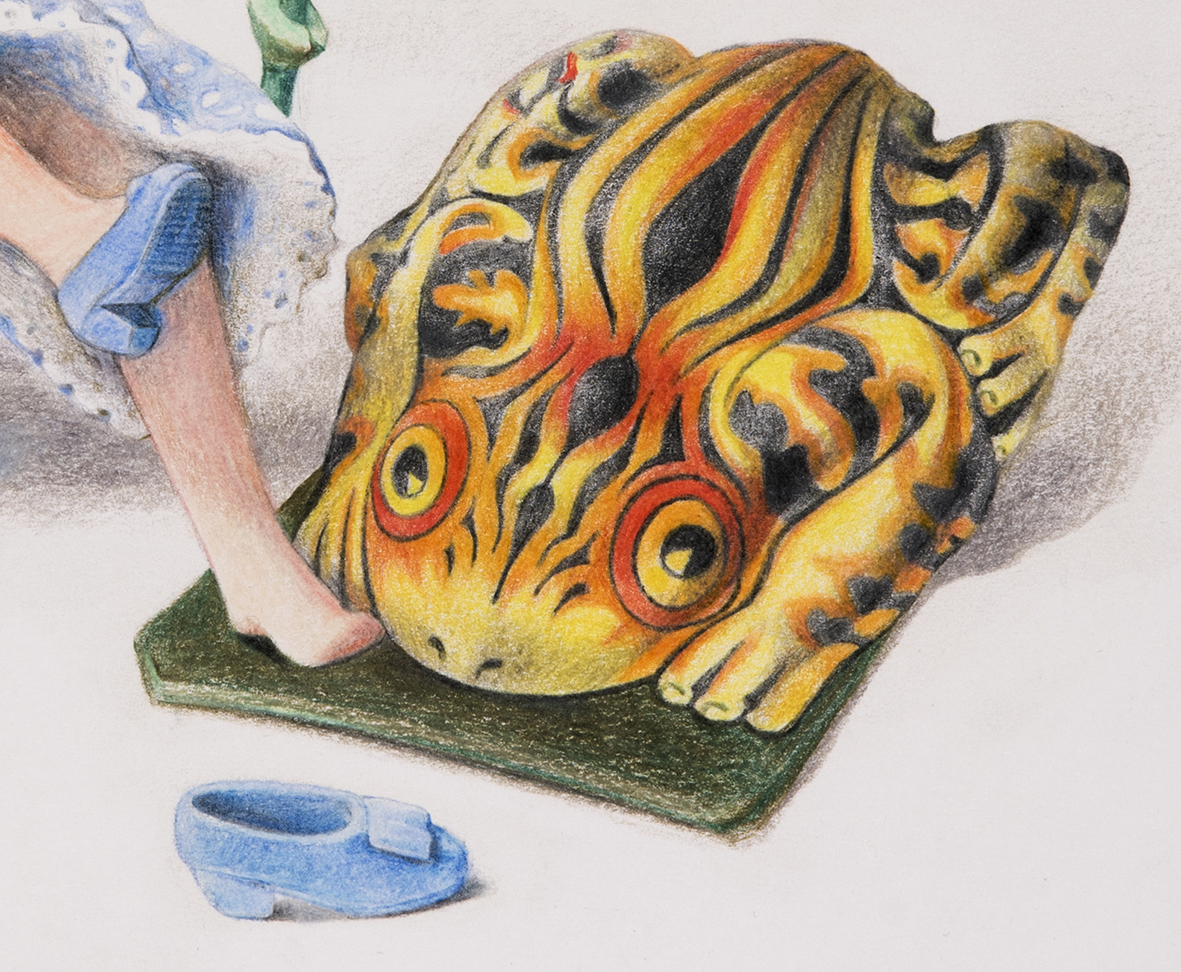 Flowerplay (Press it again to make it open)This eleventh drawing was inspired by the instruction text '...press it again to make it open...'. I wanted to explore imagery suggesting the innocent play of girl hood combined with the awareness of female adolesence and young adulthood. Perhaps this drawing is a warning from my older to my younger self? My favourite red haired Pippa doll rests one hand on the flower and the other on it's closed petals. She has lifted one leg and kicked off a shoe as she rests her naked foot next to a frog. This is a tin frog that I think my grandparents brought back from Hong Kong around 1935: it makes a very loud and sharp 'snapping' noise when you press it down onto its base. There are many interpretations of the symbolism of frogs in art (for example, as witches' familiars, fertility or transformation): each of which , and more, could apply here. I always have the imagery of one my favourite artists (Paula Rego) and writers (Angela Carter) in the back of my mind: but I think they came to the fore in this drawing.
Flowerplay (Press it again to make it open)This eleventh drawing was inspired by the instruction text '...press it again to make it open...'. I wanted to explore imagery suggesting the innocent play of girl hood combined with the awareness of female adolesence and young adulthood. Perhaps this drawing is a warning from my older to my younger self? My favourite red haired Pippa doll rests one hand on the flower and the other on it's closed petals. She has lifted one leg and kicked off a shoe as she rests her naked foot next to a frog. This is a tin frog that I think my grandparents brought back from Hong Kong around 1935: it makes a very loud and sharp 'snapping' noise when you press it down onto its base. There are many interpretations of the symbolism of frogs in art (for example, as witches' familiars, fertility or transformation): each of which , and more, could apply here. I always have the imagery of one my favourite artists (Paula Rego) and writers (Angela Carter) in the back of my mind: but I think they came to the fore in this drawing.
h:44cms x w:36cms (framed).
Coloured pencil on cartridge paper
2012 -
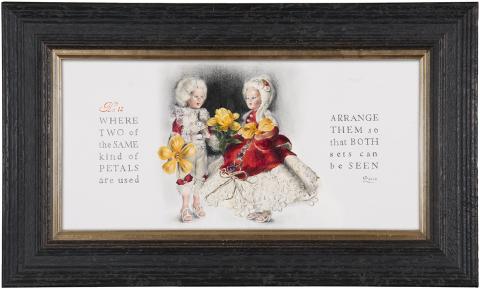 Flowerplay (Arrange them both)
Flowerplay (Arrange them both)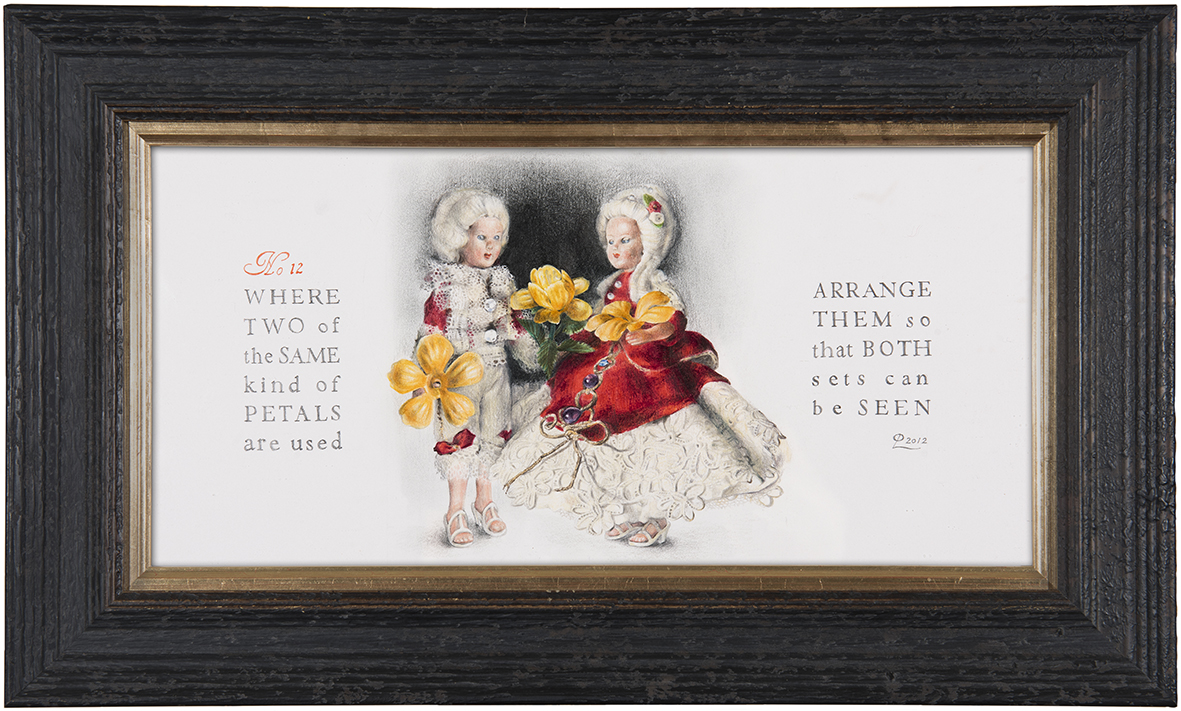 Flowerplay (Arrange them both)This is the twelfth and last drawing in the series. The text refers to duality as the flower is made up of two identical petals, one open and one closed. This made me think of imagery exploring identity: so I used a pair of vintage dolls I found on a market stall. They are exactly the same doll, each wearing the same plastic high-heeled sandals, powdered wig and elaborate lace-trimmed velvet costume: but one is dressed as a male and the other female. This is not the first time that I have drawn these dolls and I find them so intriguing that it won't be the last.
Flowerplay (Arrange them both)This is the twelfth and last drawing in the series. The text refers to duality as the flower is made up of two identical petals, one open and one closed. This made me think of imagery exploring identity: so I used a pair of vintage dolls I found on a market stall. They are exactly the same doll, each wearing the same plastic high-heeled sandals, powdered wig and elaborate lace-trimmed velvet costume: but one is dressed as a male and the other female. This is not the first time that I have drawn these dolls and I find them so intriguing that it won't be the last.
h:28.8cms x 48cms (framed).
Coloured pencil on cartridge paper
2012 -
 Flowerplay (Arrange them both)
Flowerplay (Arrange them both)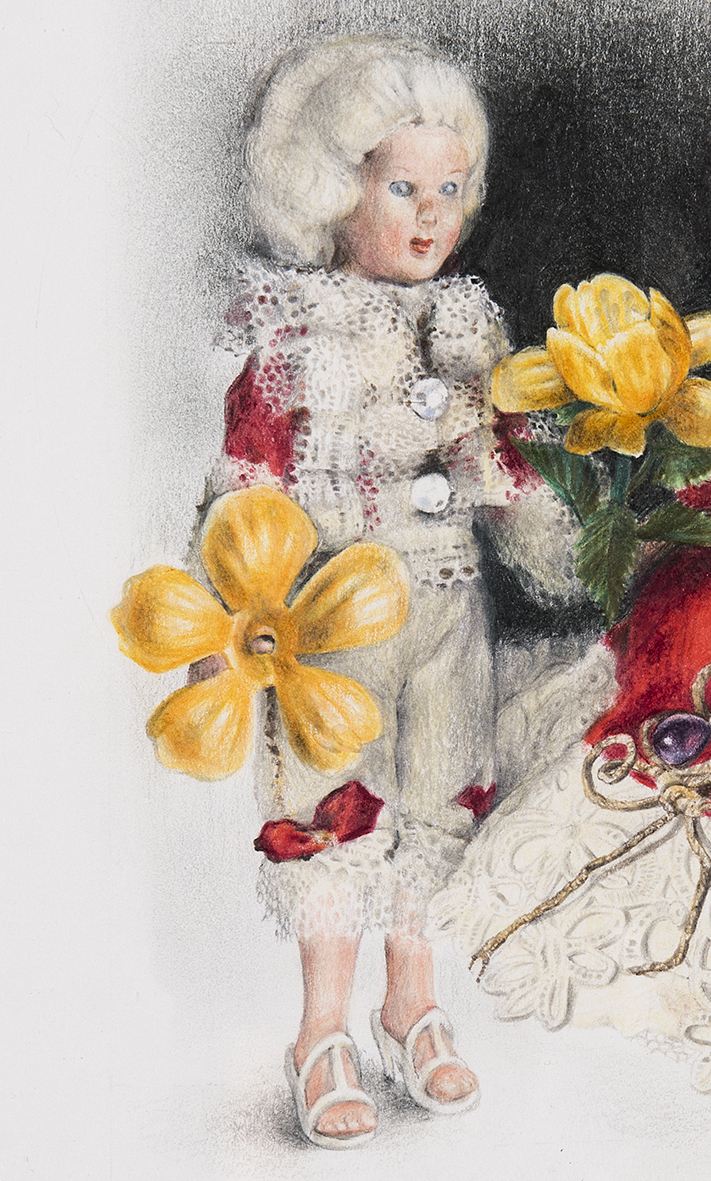 Flowerplay (Arrange them both)This is the twelfth and last drawing in the series. The text refers to duality as the flower is made up of two identical petals, one open and one closed. This made me think of imagery exploring identity: so I used a pair of vintage dolls I found on a market stall. They are exactly the same doll, each wearing the same plastic high-heeled sandals, powdered wig and elaborate lace-trimmed velvet costume: but one is dressed as a male and the other female. This is not the first time that I have drawn these dolls and I find them so intriguing that it won't be the last.
Flowerplay (Arrange them both)This is the twelfth and last drawing in the series. The text refers to duality as the flower is made up of two identical petals, one open and one closed. This made me think of imagery exploring identity: so I used a pair of vintage dolls I found on a market stall. They are exactly the same doll, each wearing the same plastic high-heeled sandals, powdered wig and elaborate lace-trimmed velvet costume: but one is dressed as a male and the other female. This is not the first time that I have drawn these dolls and I find them so intriguing that it won't be the last.
h:28.8cms x 48cms (framed).
Coloured pencil on cartridge paper
2012 -
 Flowerplay (Arrange them both)
Flowerplay (Arrange them both)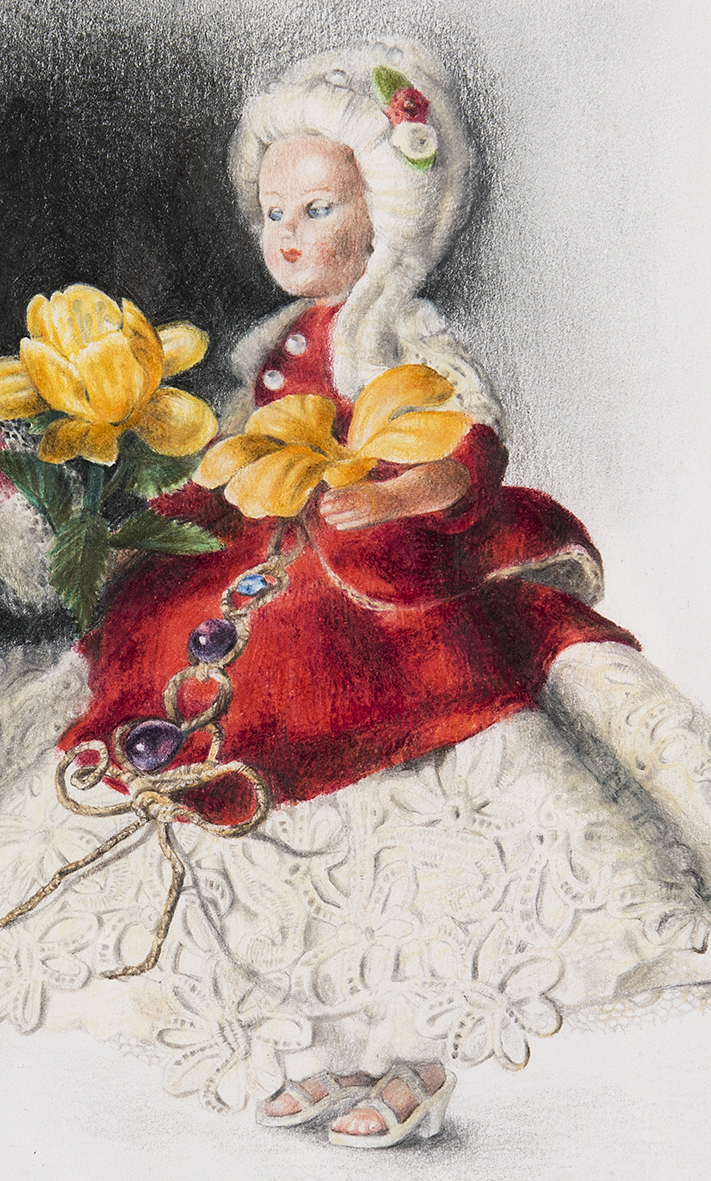 Flowerplay (Arrange them both)This is the twelfth and last drawing in the series. The text refers to duality as the flower is made up of two identical petals, one open and one closed. This made me think of imagery exploring identity: so I used a pair of vintage dolls I found on a market stall. They are exactly the same doll, each wearing the same plastic high-heeled sandals, powdered wig and elaborate lace-trimmed velvet costume: but one is dressed as a male and the other female. This is not the first time that I have drawn these dolls and I find them so intriguing that it won't be the last.
Flowerplay (Arrange them both)This is the twelfth and last drawing in the series. The text refers to duality as the flower is made up of two identical petals, one open and one closed. This made me think of imagery exploring identity: so I used a pair of vintage dolls I found on a market stall. They are exactly the same doll, each wearing the same plastic high-heeled sandals, powdered wig and elaborate lace-trimmed velvet costume: but one is dressed as a male and the other female. This is not the first time that I have drawn these dolls and I find them so intriguing that it won't be the last.
h:28.8cms x 48cms (framed).
Coloured pencil on cartridge paper
2012